German Quark Cheese is a simple soft cheese that is easily made at home. It is a versatile and delicious German kitchen staple!
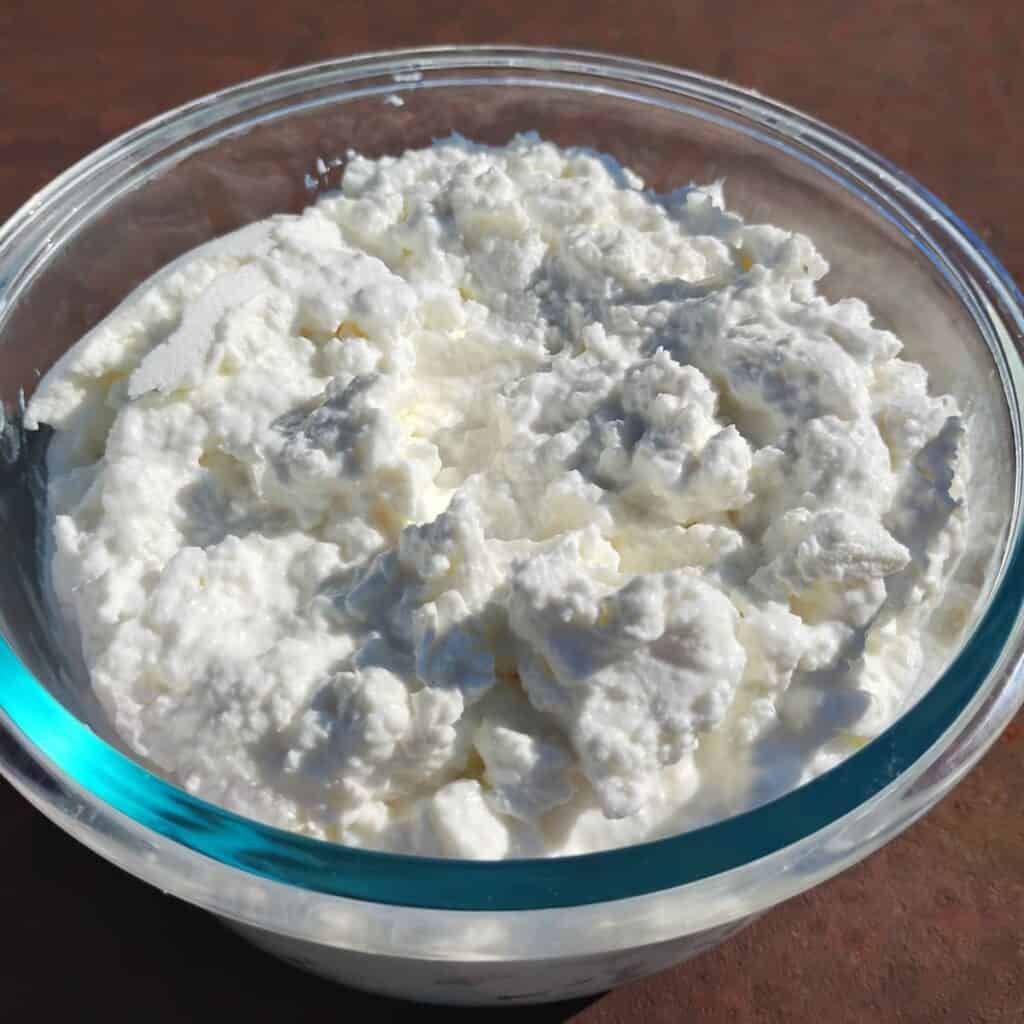
This post contains affiliate links. As an Amazon affiliate, I make a small commission at no extra cost to you if you make a qualifying purchase. See my full disclosure here.
If you’re German, you’ll know Quark! In Germany, Austria or Switzerland, it’s sold in every grocery store as Quark or Topfen and it’s a staple that’s used in much of German cooking and baking. While everyone knows Quark in Germany, here in America this is a little known dairy food. Look in your grocery cold case and you’ll be hard pressed to find Quark. Try the health food store and your chances might be a little better.
I had to learn to make Quark because I grew up in Germany, and living in America now, it was a hardship not finding quark for daily use. Cream cheese doesn’t come close and cottage cheese isn’t quite the same. Neither is farmer’s cheese. So what else is there to do than make your own? This is just what we’ll do here and I’m certain, if you don’t know quark yet, you’ll fall in love with it.
There are several ways you can arrive at some sort of Quark. I’ll give instructions for my favorite way to make it, which is the traditional method, and, in my opinion, yields the only true quark, which is full of live, beneficial bacteria, and tastes fantastic. It is easy to make, don’t let the lengthy intro deter you, but some things need to be explained. The process however, is super easy! If you’re familiar with cheesemaking, you can just jump to the recipe.
If you love homemade cheese, you might like to make Chevre from goat’s milk, or Clabber Cheese from any raw dairy milk. And give Sirene (Bulgarian Feta) a try! Make the quickest cheese ever, Queso Fresco. And don’t forget to read about how cheese happens in the Natural Cheese Making. If you don’t have access to raw milk, Make Cheese With Sourdough Starter from scratch.
Here are some delicious recipes for using Quark, a sweet creamy Quark Dessert With Oranges, a very berry Strawberry Quark Mousse, refreshing Lemon Cheesecake Mousse, amazing Lemon Blueberry Cheesecake Bars, awesome Blackberry Cheesecake Streusel Bars, fantastic Maple Walnut Apple Pie Cheesecake Bars, and a super delicious Traditional German Cheesecake!
- All about Quark cheese and How it Is Made
- What the heck is Quark?
- How Traditional Quark Is Made
- Tips For Making Awesome Quark Cheese
- Different Ways To Make Quark
- How To Make The Best Quark
- What To Do With All That Whey?!?
- Your Questions Answered
- So Now That You Have Some Wonderful Quark, Enjoy It!
- What to read next
- Pin This Post
- Shop This Post
All about Quark cheese and How it Is Made
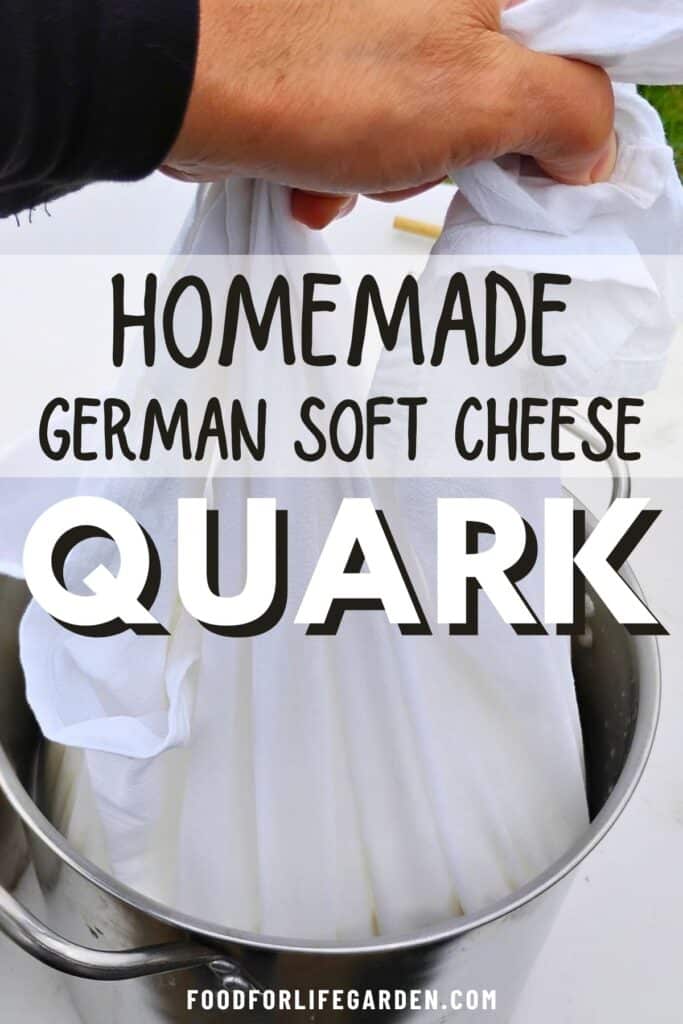
Well, since my goats are heavily back in milk after a bit of a break before kidding, I am back to making cheese and am resuming my cheese making series here on the blog. Watch for more to come soon, as I’m already working on several more recipes even as I’m writing this one. I’ll be exploring other simple but a bit more advanced cheeses next. So stay tuned.
There are many substitutions listed when you try to look up how to replace quark. However, none of them are quark and quark truly is its own animal. You might find fromage blanc or fromage frais which are similar, but creamier. And those are not exactly common in the stores either.
Since a lot of German cooking and baking revolves around quark, and I happen to love it, I needed to start making my own. I found it once in a health food store and it did not taste great. It tasted barney and not at all fresh. The best solution to having fresh quark on hand is to make your own. This is what we’ll do here.
But first things first…
What the heck is Quark?
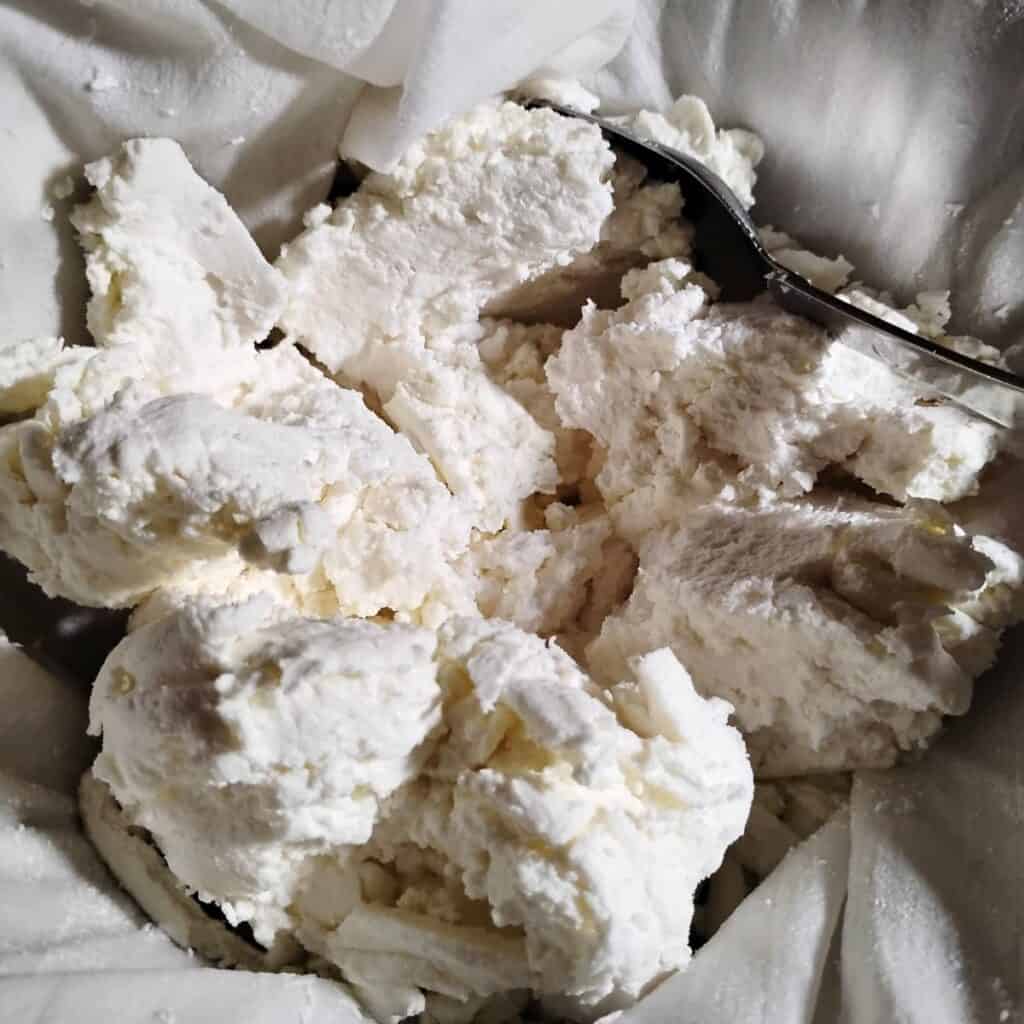
Ok, we’re not talking about elementary subatomic particles here. And no, this is not a new Star wars space invader. This Quark is a super healthy probiotic cheese that is sold as a staple in all German markets, as well as in many other European countries.
Quark is a mesophilic, mild, fresh cheese, normally made from cow’s milk, which is soft and spreadable. It is most often low in fat content, made from partly skimmed milk.The consistency and texture reminds me of soft chevre or strained yoghurt cheese like labneh or Greek yogurt.
However, quark is a mesophilic cheese that contains lactococcus lactis bacteria, which grow in medium room temperatures (68-80 ℉). This is unlike yogurt, which uses thermophilic bacteria and a warm environment (90-110 ℉) for incubation. Mesophilic bacteria love medium temperatures and thermophilic bacteria love warm temperatures.
Depending on the temperature you heat your milk to and your ambient temperature during incubation, you’ll activate the respective bacteria that are inherent in raw milk.
The flavor of quark is fairly mild and it is not usually stored for more than a couple of weeks. However, if you salt it, you can age it for a few months, though it will start to taste stronger and more ripe, especially if you use goat’s milk as a base.
How Traditional Quark Is Made

Traditionally, Quark is made with clabbered milk, which is raw milk that has gone sour. And as such it is quite similar to bonny clabber, in fact the strained clabber cheese and quark can be used interchangeably. But quark often has a tiny bit of rennet added in the process, which makes the curds a little more firm and a bit drier.
Quark can surely be compared with chevre too, but chevre is made from goat’s milk, as the name implies, and it has drier curds and is normally salted. Chevre is most often used in savory applications.
I’ve used homemade chevre (with no goaty flavor) instead of quark many times just by leaving out the salt, but if you get chevre in the store, it most likely has that strong goaty flavor which doesn’t lend itself for use in sweet dishes, and is often too strong tasting for most baked or cooked applications.
Tips For Making Awesome Quark Cheese
Here are a few basic considerations for making quark cheese and many other cheeses too.
What milk to use and what to consider
Raw Milk
I recommend raw milk: I’m going through the process with you today using raw goat’s milk, but you can use raw cow’s milk just the same. I’ll be using whey from naturally cultured raw milk. But there are ways to make it with pasteurized milk and store bought cultures.
You’ll be using less culture and rennet when you use raw milk and you don’t need any other additives.
Pasteurized Milk
Pasteurized milk does not work for making your own cultures. All the good bacteria has been killed and some new ones must be introduced by adding a culture.
But you certainly can use pasteurized milk for making cheese and quark as long as you add live bacteria cultures.
Ultra-pasteurized milk is too far denatured to be used for any cheese making, so don’t us it for this recipe. Only use regular pasteurized milk.
If you use pasteurized milk and you find that it doesn’t want to coagulate well, you may need to add calcium chloride next time. The calcium in pasteurized milk has been inhibited during pasteurization and normally needs to be replaced.
Pasteurized milk is not like raw milk. The enzymes are inactivated, natural probiotics are destroyed, healthy fats, proteins, and vitamins are altered, calcium and potassium are inhibited and immunoglobulins are destroyed.
Pasteurized milk experiences structural changes. This is one reason why it might be hard to digest for so many people and why many people experience discomfort and even allergic reactions to drinking milk.
Adding a culture to make cheese will do a great service to pasteurized milk by adding some good bacteria back in and this can make it much easier on the gut.
If you would like to know more about raw milk, I found an interesting article from the Raw Milk Institute that does a great job at addressing the raw milk debate.
Temperature:
Your room temperature matters when making cheese. A mesophilic cheese such as quark, likes to incubate at temperatures no lower than 68 ℉ and no higher than 90 ℉. My best cheeses happen around 75-80 degrees room temperature. The lower the temperature, the longer the incubation time, so keep that in mind when you check on your cheese.
In the case of Quark cheese it does not need very high temperatures. If your room is 68-70 degrees that is fine, it just may take a little longer for the whole process and the cheese will turn out less tangy.
Cheese drains easier at warm temperatures, so you may want to find a warmer spot for draining it.
Sterilization
I never sterilize anything. There are so many bacteria and microorganisms flying around in the air at any time, that as soon as you sterilize something, it will become populated again instantly with airborne organisms, unless you’re working in a sterile laboratory. So you can’t keep the good or bad bugs out if you try. However you’ll want to start with clean equipment and utensils and wash everything in hot soapy water when you’re done, and rinse well.
You might also consider your cheese making environment. Try to stay away from competing bacteria and yeasts, such as when making yeast bread dough or wine. And if you have a compost bin, maybe stay a few steps away from it when making your cheese. This can avoid the wrong bacteria taking hold of your cheeses.
Incubation time:
This depends much on your ambient temperature. I incubate at around 75 degrees currently and temps dip to about 68 at night. So I let this Quark ferment for roughly 24 hours. It might be quicker if it’s hot out or slower if your temps don’t go over 70. I also wrap a thick towel around my container with the milk in it, to keep the temperature throughout the contents of the pot more consistent.
How Cheese Happens:
If you’re new to cheese making, I recommend that you read my post about the natural cheese making process for more detail and to learn what goes on when you make cheese. There you will also find the recipe for making a mesophilic culture, which is what we need for this Quark cheese.
Different Ways To Make Quark
There are dozens of different ways to make Quark if you try to find a recipe on-line. Some sound a bit strange and don’t make much sense, but it looks like they yield some sort of quark. Many use fairly high heat, which doesn’t actually yield a cultured mesophilic quark, and the high temperatures kill the beneficial bacteria. It does make a type of quark, but not a cultured traditional quark.
Yogurt cheese or strained yogurt can be used as a substitute in some recipes, but it does not behave or taste the same as quark.
I’ll give you my version below that I think yields the best and most traditional quark. If you have raw milk, you can just let it clabber and strain it, as I described in the bonny clabber recipe. This would be the truly authentic way to do it.
And once you make clabber cheese, you can save the whey as a starter culture for your next batch, and use it to speed things up from there on out. And here we’ll assume that you already have some whey from a previous batch or some other sort of culture. Scroll down to find out more about choosing a culture below.
How To Make The Best Quark
Alright, let’s get to the recipe. I used 2 gallons of milk, which is my minimum for most cheeses, but I’ll be listing ingredients for 1 gallon here. You can most certainly double everything, if you want more cheese. I think it is more efficient to make bigger batches at a time, considering all the dishes and time involved. But 1 gallon is a great amount if you want to get your feet wet.
Equipment
A large 6 qt pot – If you’re starting with warm milk, straight from the animal, it will not need to get heated. Then you can use any non-reactive container for incubation, but I recommend stainless steel or glass. Here is a 12 quart stock pot that is a perfect size for a 2 gallon batch of milk.
A skimmer with holes – if you don’t have one, you can stir with a slotted turner or even a long spoon, but a utensil with holes will mix things better. I use this to mix in the culture and rennet and for transferring the curds later.
Thermometer – I recommend this cheesemaking thermometer. I’ve been using mine for almost a decade and it’s awesome. It has a long enough stem for large batches of cheese too.
Micro measuring spoons – great for measuring out small amounts of culture powder or rennet.
Measuring cups – 1/2 cup for diluting the rennet in water and for measuring the starter culture.
A cheesecloth – Do not use the kind from the grocery aisle. It won’t work. Use a flour sack towel, tea towel, piece of muslin, butter muslin, or cheesemaker’s cheese cloth. Cloth diapers work really well too for one gallon batches of this recipe, but they are too small for a 2 gallon batch. You can also use a nutmilk bag, but I don’t like how the seams are impossible to clean well.
A second pot or large bowl – for transferring your curds later.
Storage container – any non-reactive container can work, though I recommend glass, or stainless steel. Plastic can leach off-flavors and chemicals and the acidity of the cheese can leach particles from metal such as aluminum.
Ingredients
Starter Culture
Milk
Rennet
Optional Calcium Chloride
Optional Salt
Filtered Water
Milk

Raw milk is going to yield the best results in every way and for its health benefits, it is not replaceable. I use only raw goats milk currently, but I had cows before and used raw cow’s milk in the past and that works just as well.
But I realize that raw milk is not available to everyone, and so I’ll include instructions for pasteurized cow’s milk. The good thing when making cheese with your pasteurized milk is that some of the good bacteria gets added back in, which makes pasteurized milk a little healthier again.
Do avoid ultra-pasteurized milk. This won’t work for most cheese recipes because it has been over processed and denatured. It is structurally very different from raw milk and even from pasteurized milk.
I use full fat goat’s milk for my quark and it yields a very rich quark. But most quark you buy in Germany is actually low fat.
You can use 2% milk to get a less fatty quark, which will most resemble what you can get in German markets. If you use raw, or un-homogenized cow’s milk, just skim off some cream to use elsewhere and use the skimmed milk for quark. You can add the cream back in later for a creamier quark. don’t ask me why this is how they make Sahnequark, or ‘cream’ quark in Germany, but that’s how they do it.
Natural Starter culture
Here you have several options.
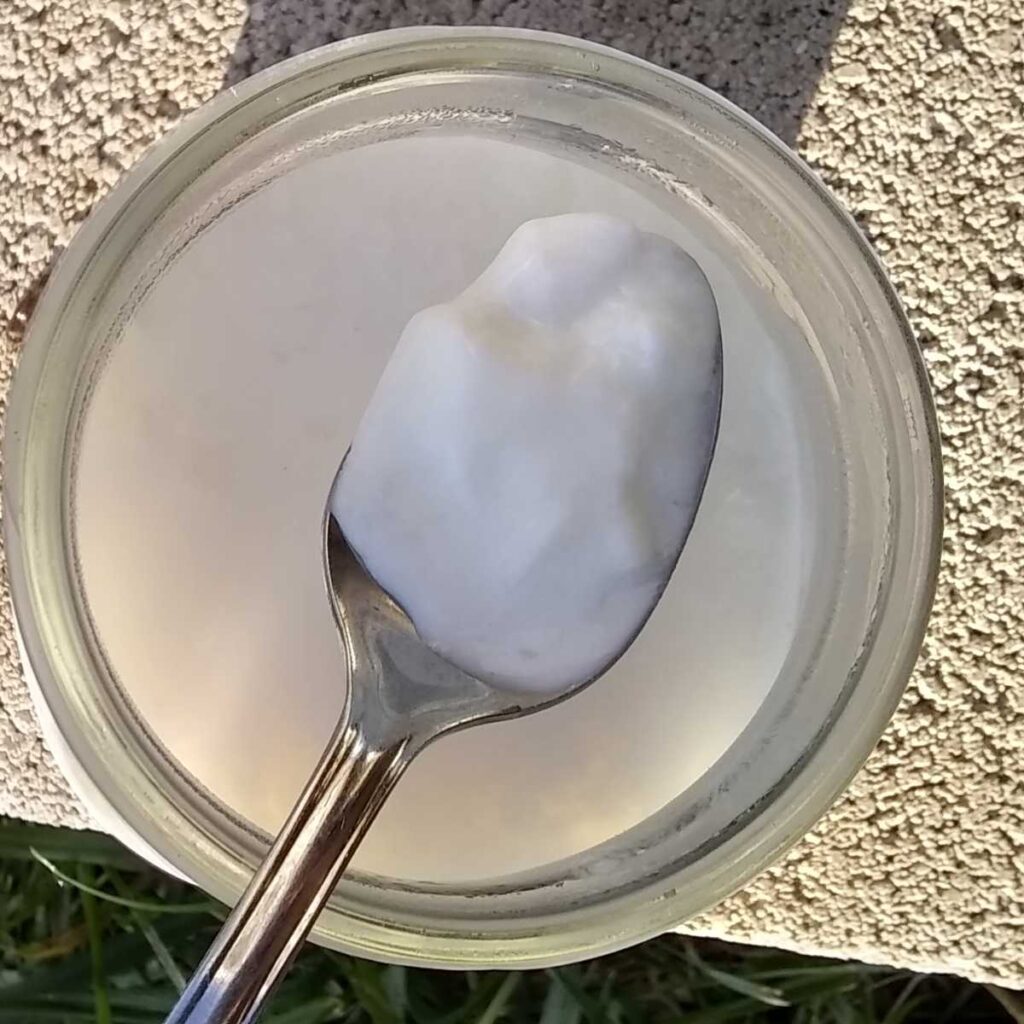
Make your own starter culture if you have raw milk available. See how in the natural cheese making process and follow the instructions to make mesophilic culture. Or just follow the instructions on making bonny clabber, which will be your starter culture. This is the ideal and preferred way to make a natural, traditional quark.
You can also use mesophilic whey from previous cheese making. Use the unsalted whey from any cheeses that have been cultured at medium temperatures.
Another culture you can use is buttermilk from the store. However, you’ll need to make sure that it contains live bacteria. This won’t work with pasteurized buttermilk. The health food store might be your best place to get a live culture buttermilk.
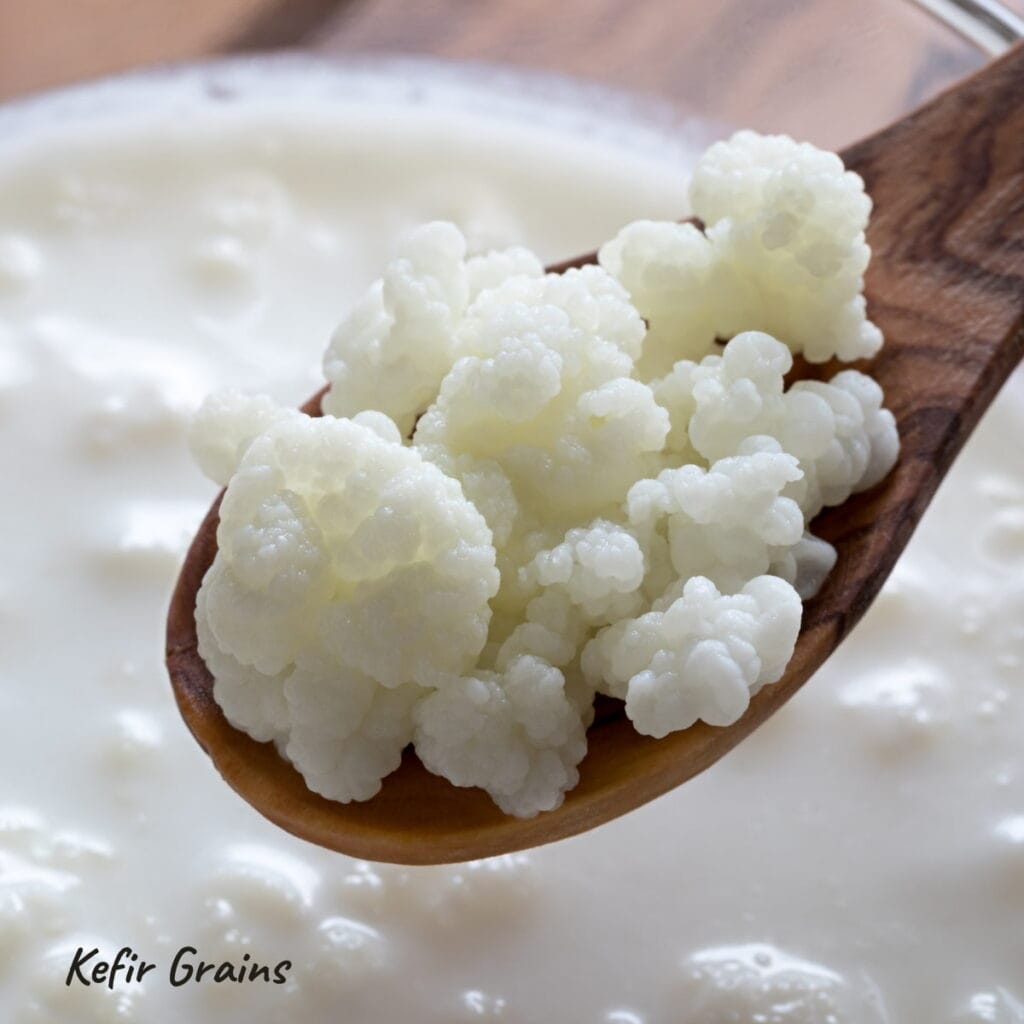
If you have access to milk kefir, it will make a superb starter culture for your Quark. I recommend live grains if you want to start your own. Kefir has a huge diversity of living organisms, greater even than yogurt and you’ll get lots of good bacteria to feed your gut microbiome when using it.
Kefir isn’t the best starter culture for all cheeses since it introduces carbonation, but it is awesome for many. I’ve made all sorts of cheeses using kefir with great results. In fact if you can’t find buttermilk with live bacteria in the store you might be able to find an unflavored milk kefir, which normally includes live bacteria. Check the label though.
Use Sourdough Starter
This is another natural option that I recently came upon and tried and it works wonderfully. If you lack raw milk for making your own natural cultures from scratch, do give sourdough a try. Just add a spoonful to a pint of milk, let it clabber, then take a spoonful of the clabber and and add it to another pint of milk. Each time this will take about a day. After doing this for 3-4 days you should have a pretty nice starter culture for making cheese as described in the recipe.
Read more about using sourdough starter culture to make a cheese starter culture for making quark in ‘How to make a Cheese Culture With Sourdough Starter‘ from scratch. No raw milk required!
Purchased Freeze Dried cultures
Your final option is a purchased labratory manufactured mesophilic culture such as flora danica, which has a more diverse selection of bacteria than your standard freeze-dried mesophilic cultures. You’ll use 1/8 teaspoon and sprinkle it over the top of the warmed milk and let it rehydrate for a few minutes before stirring it in. Flora danica would be my first choice from all the freeze dried options.
Alternatively you can purchase buttermilk culture. And you can also use generic freeze dried mesophilic culture, but it will not yield as good of a result due to the type of bacteria it is based on.
In a pinch, freeze dried, direct set chevre culture or fromage blanc culture will also work. However, do not use rennet with these. It is already included. And if you’re adding any cultures to raw milk, cut the recommended amount in half.
Calcium Chloride
You don’ t need this when you use raw milk! But since calcium becomes denatured by pasteurization, you might need it for pasteurized cow’s milk. If you have trouble getting your cheese to coagulate, I’d add some calcium chloride in your pasteurized milk next time to fix that.
Rennet

Rennet is optional for this cheese if you use raw milk. Using rennet yields a firmer, quicker cheese. Omitting rennet yields a softer, creamier and tangier cheese that takes a little longer to make. I prefer it without rennet, but I often use rennet if I want it to go faster. It will set and drain quicker.
And I recommend that you use rennet with pasteurized milk in any case. It lacks the beneficial bacteria that is needed for a strong fermentation. Pasteurized milk needs all the help it can get.
I use kid rennet for my cheeses for two reasons. One, Walcoren uses all natural organic, non-gmo ingredients, and second, because I use goat’s milk and I feel that it is a good match. I prefer the liquid kid rennet. This needs to be kept refrigerated. I’ve had my bottle for many years and it still works. You need very little for each batch of cheese. You can also get Walcoren Kid Rennet Tablets, I like them, they have a long shelf-life, but I find them harder to dose and they take a few minutes to dissolve.
If you like, you can use kid rennet for cow’s milk as well, it contains enzymes that can actually enhance the rather bland flavor of cow’s milk in cheeses. Many cheesemakers add lipase enzymes to their cow’s milk cheeses for this reason, but you can skip that if you use kid rennet in your cheese making. It already contains such enzymes and will give your cheeses a more complex flavor.
However, the most common rennet used is calf or animal rennet. Look for a non-GMO version.
Some people use vegetable rennet. I heard that it makes aged cheeses bitter and that it is better used only on fresh cheeses. I have never used it and don’t intend to. But it is an option if you prefer using vegetable rennet.
We’ll be using very little rennet to arrive at the soft, creamy nature of this quark cheese. It needs to be dissolved in water before getting added to the milk. Take a quarter cup of water and place three drops of rennet into it. Stir and use only a tablespoon of this mix per gallon of milk for raw milk. If you use pasteurized milk, use two tablespoons.
Salt
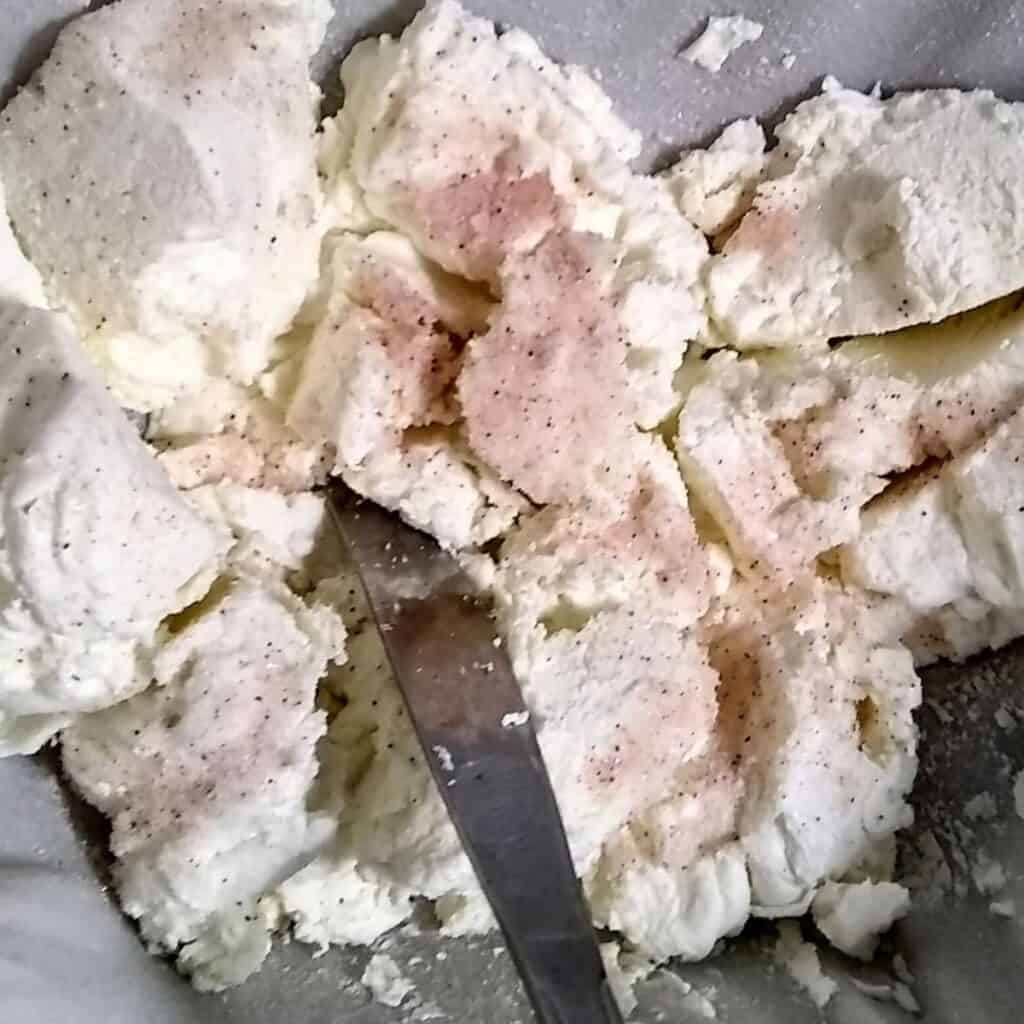
Salt is not normally used for the basic quark, but it is used in recipes with quark. However, if you want to store your quark long-term and plan to use it as a savory ingredient, you can salt it. Use 1 teaspoon per half pound of cheese. I stuff mine into pint canning jars. Eliminate air pockets and fill to the very top for best results. Seal tightly.
There is actually a special salt for cheese making available. It is a flake salt that works especially well in certain cheeses. I used to buy it way back when I first started making cheese, but now I just use a good quality mineral salt.
Unrefined sea salt is great or you can use a kosher salt. Do read the package label though, it can not have additives. My favorites are Redmond’s Real Salt, Himalayan Pink Salt, or Celtic Sea Salt. The pink salts do tend to give the cheese a little pinkish hue though and you’ll see tiny pink specks throughout.
Filtered water – Avoid chlorinated water such as tap water. Chlorine is meant to kill bacteria and we need those! Bottled water will work too. I like to filter my trucked-in well water or rain water with my Royal Berkey filter unit.
Instructions For Making Quark
01 Warm Your Milk
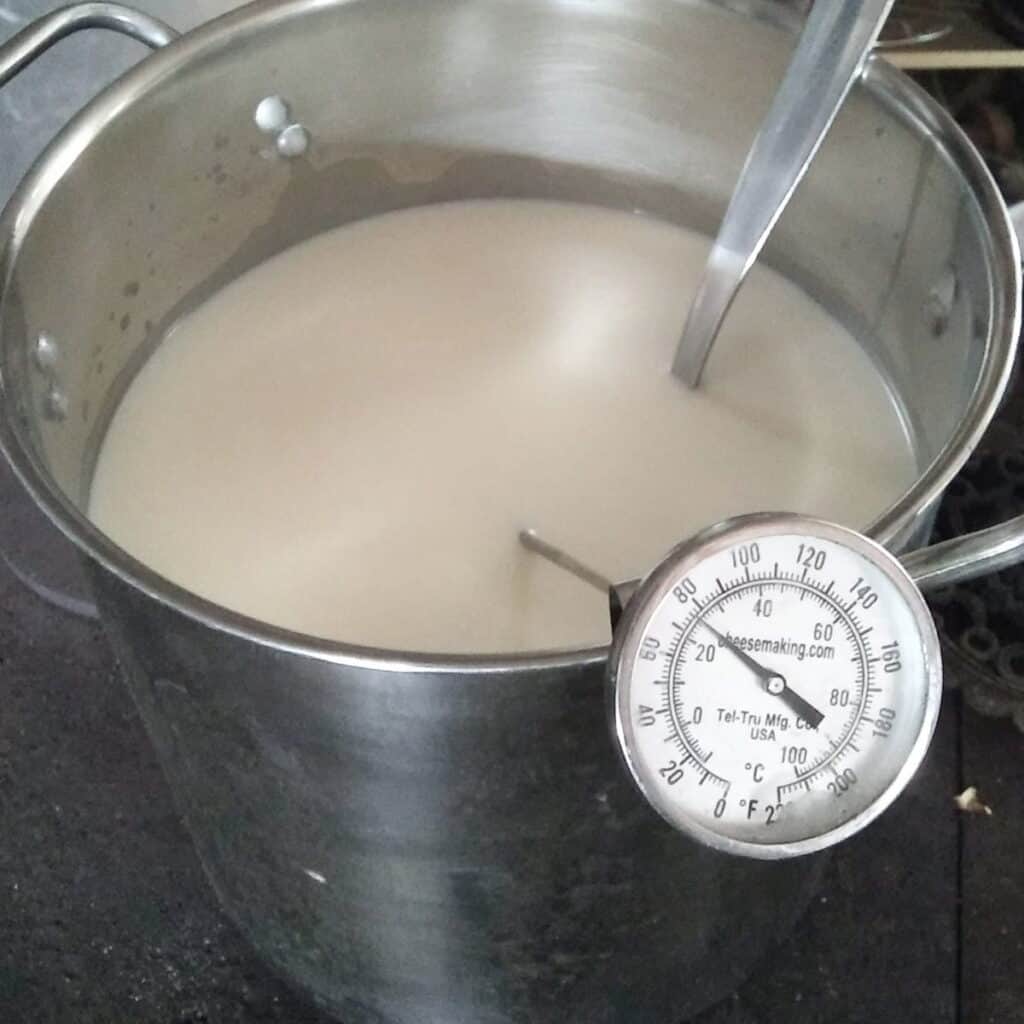
Slowly warm your milk while stirring occasionally. Heat it to 80 degrees if it’s goat’s milk. Heat it to 86 degrees if it’s cow’s milk. If you’re taking milk straight from the dairy animal, there is no need to heat it first, just pour it into your cheesemaking pot and proceed.
02 Add Starter Culture
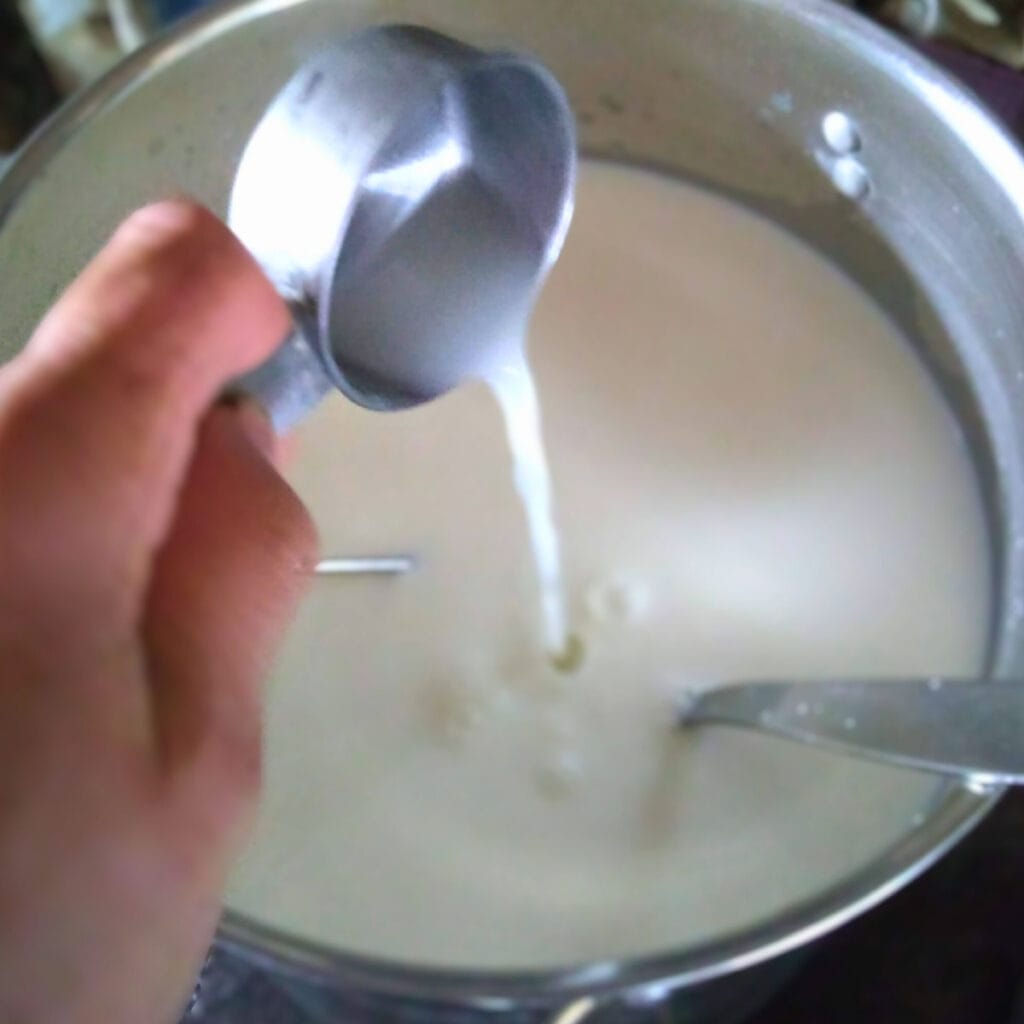
Take the pot off the heat and add the starter culture. If you want use calcium chloride, add it now as well. If you’re using a freeze dried culture, sprinkle the correct amount over the top of the milk and let it hydrate for two minutes. Then stir it in.
Stir well with an up and down motion, and try to stay below the milk surface.
03 Add Rennet
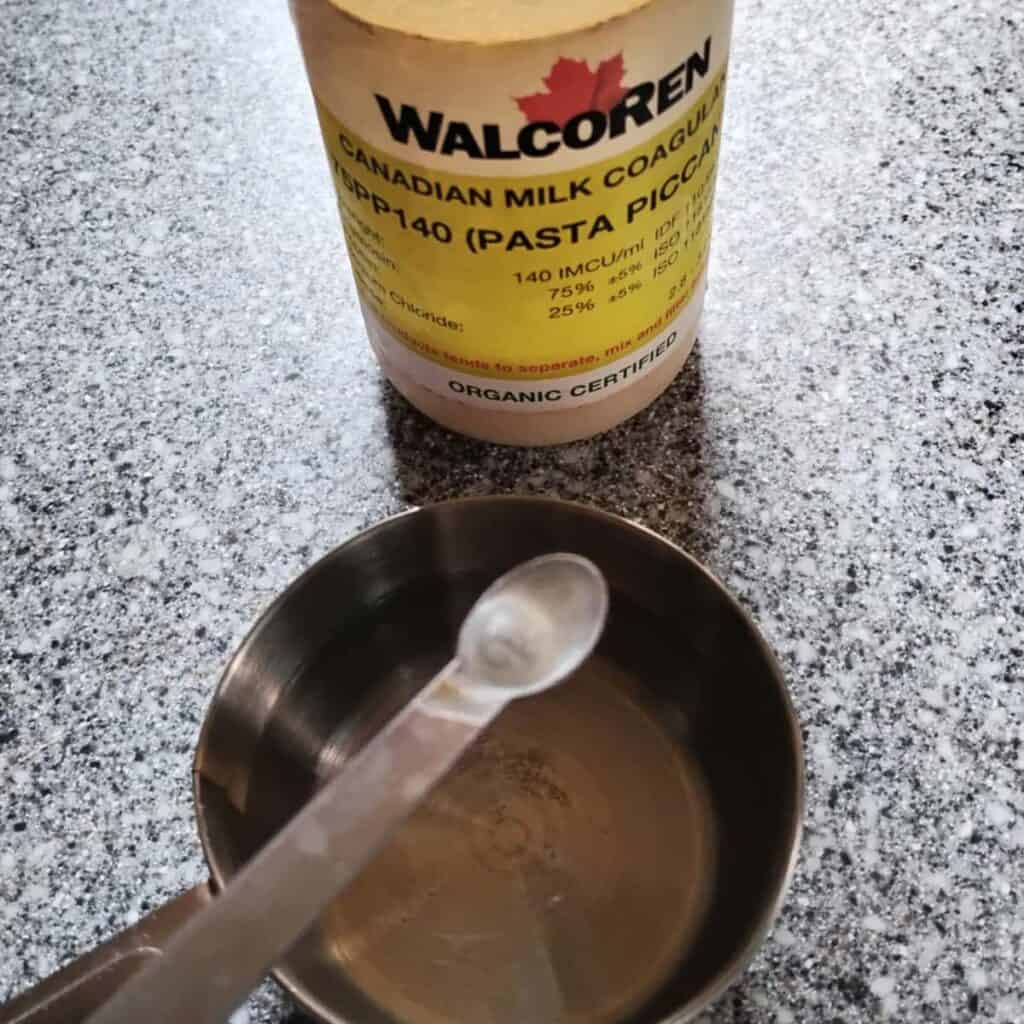
Prepare your rennet by diluting it in 1/4 cup of water.
If you use rennet, add one tablespoon of the the diluted rennet now and stir well with up and down motions without breaking through the milk surface. Only stir for about 20 strokes, then use your skimmer to stop the milk movement. The rennet will start working immediately and the milk should stay very still throughout this incubation period. Cover the pot and don’t move the pot till it’s done. Jiggling it might break the curd inside which will release whey and disrupt the process. Rennet only works once.
04 Incubate

Wrap the pot in a thick towel and let it sit undisturbed for 12-24 hours. In a cool environment it might take longer.
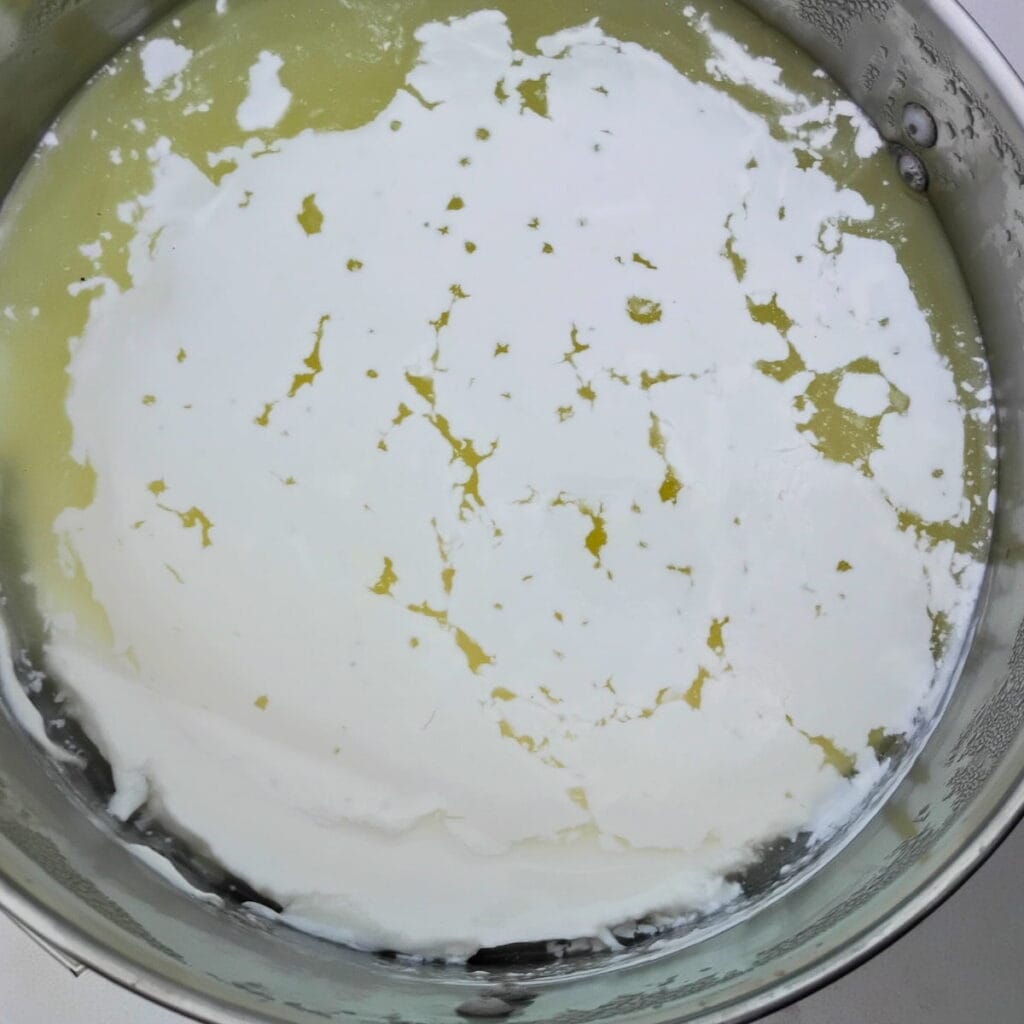
If your room is very warm, check after 12 hours to see if your whey is separating. You’ll see a curd cake in a bath of whey if it has. Take a knife and make a small cut into the curd to see if it breaks cleanly. If not, give it more time. Otherwise you can proceed.
05 Transfer The Curds
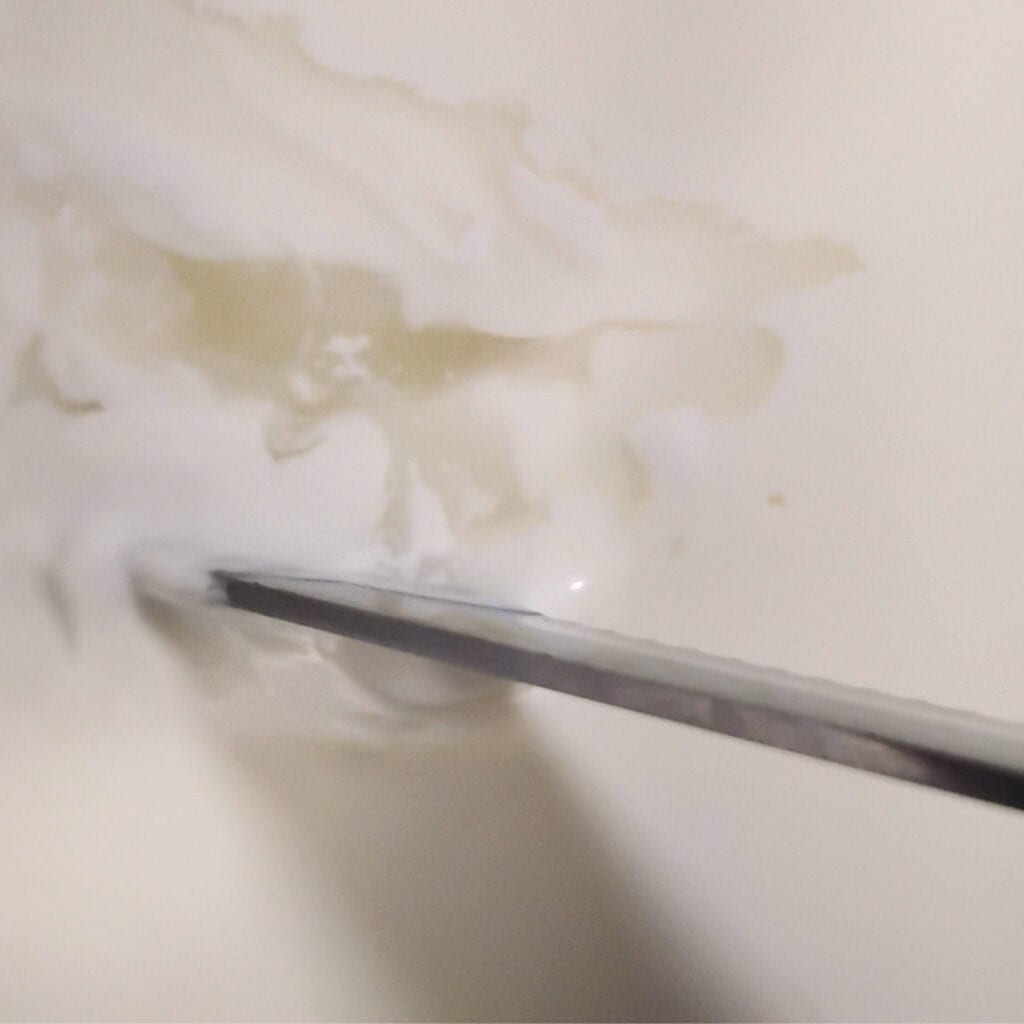
Once the curd and whey start to separate and you get a clean break when you cut the surface of the curd, It’s time to drain the curds.
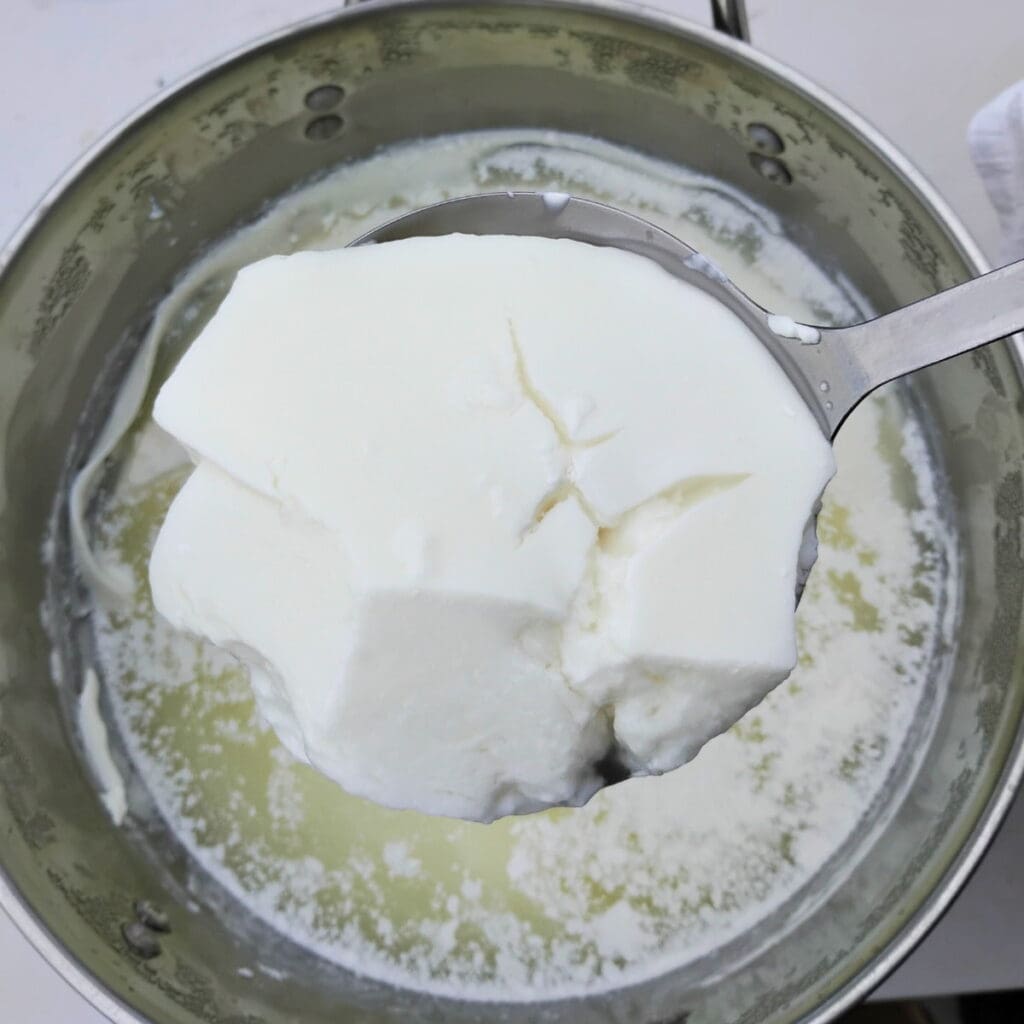
I like to pour off some of the whey into another container first, if possible. But you don’t need to do that.
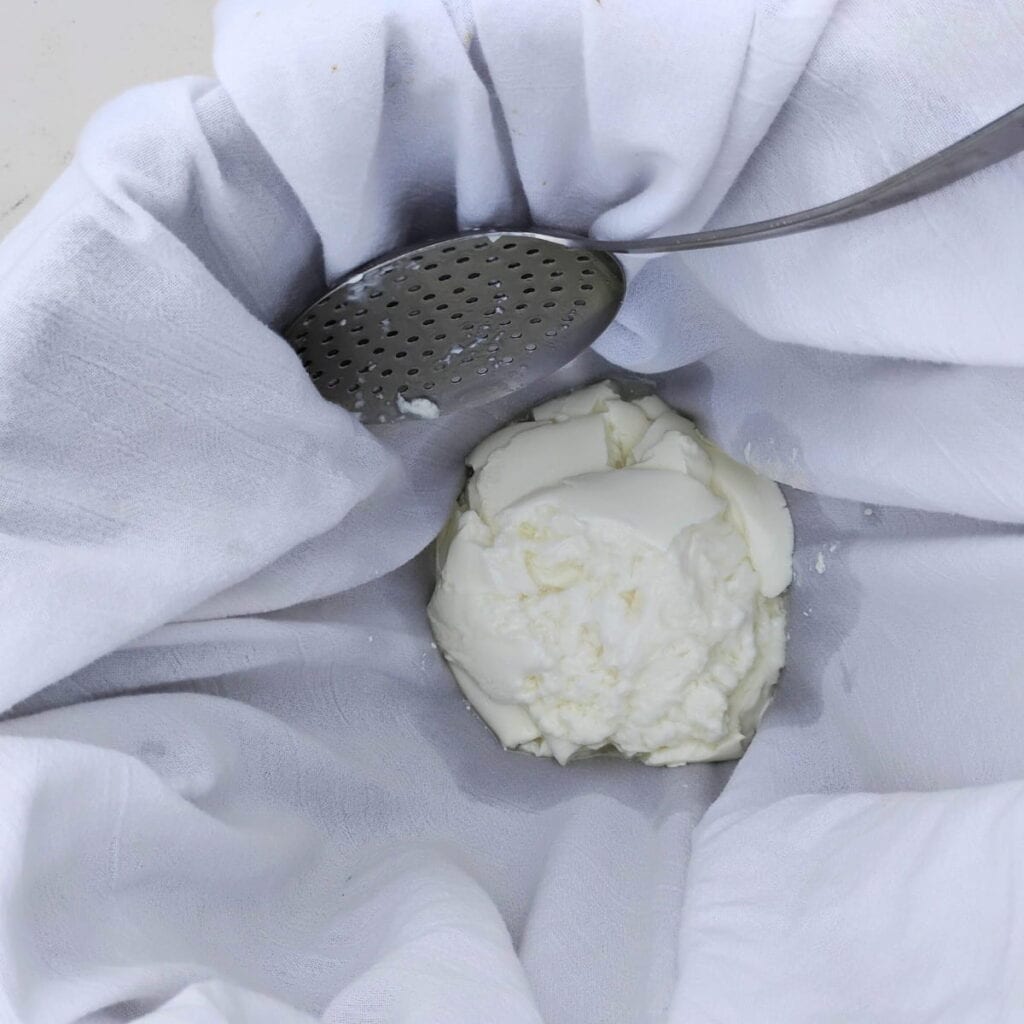
Line a second pot or large bowl with a cheesecloth. Take your skimmer and cut into the curd, taking slices and transferring them to the cloth-lined pot until you have all of it.
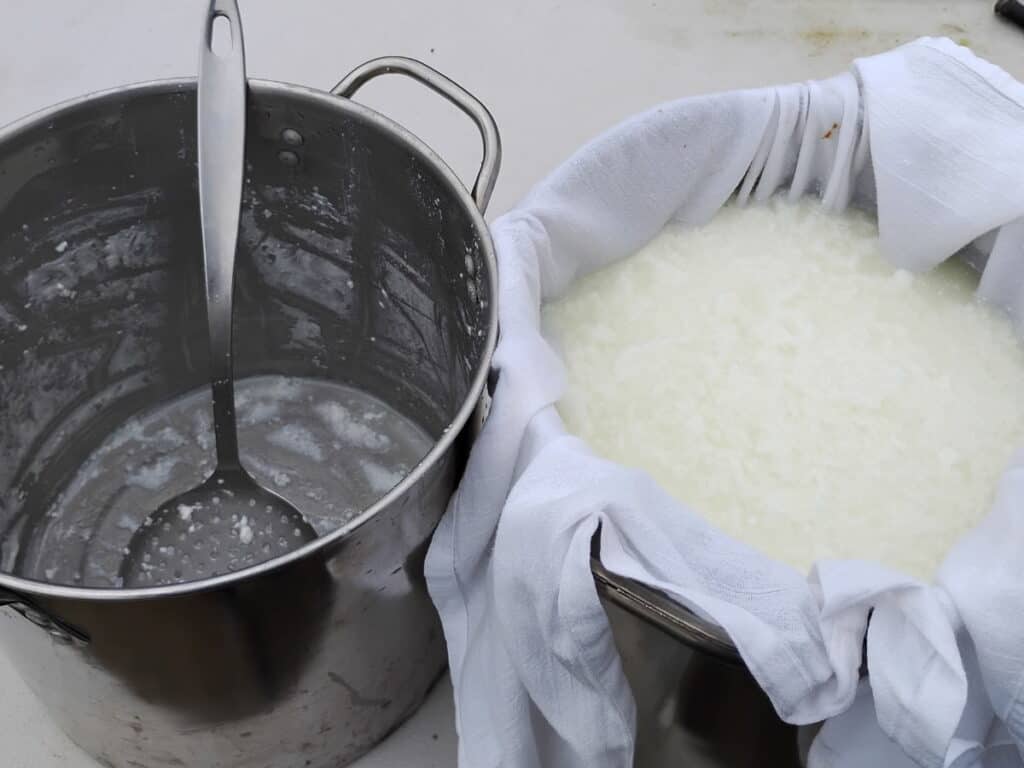
If you want to pour the rest on the bottom of the pot into the cheesecloth, do so carefully, using your skimmer to keep it from splashing too hard. You don’t want to mash the curds or paint your kitchen, or maybe you do?

06 Drain the Curds
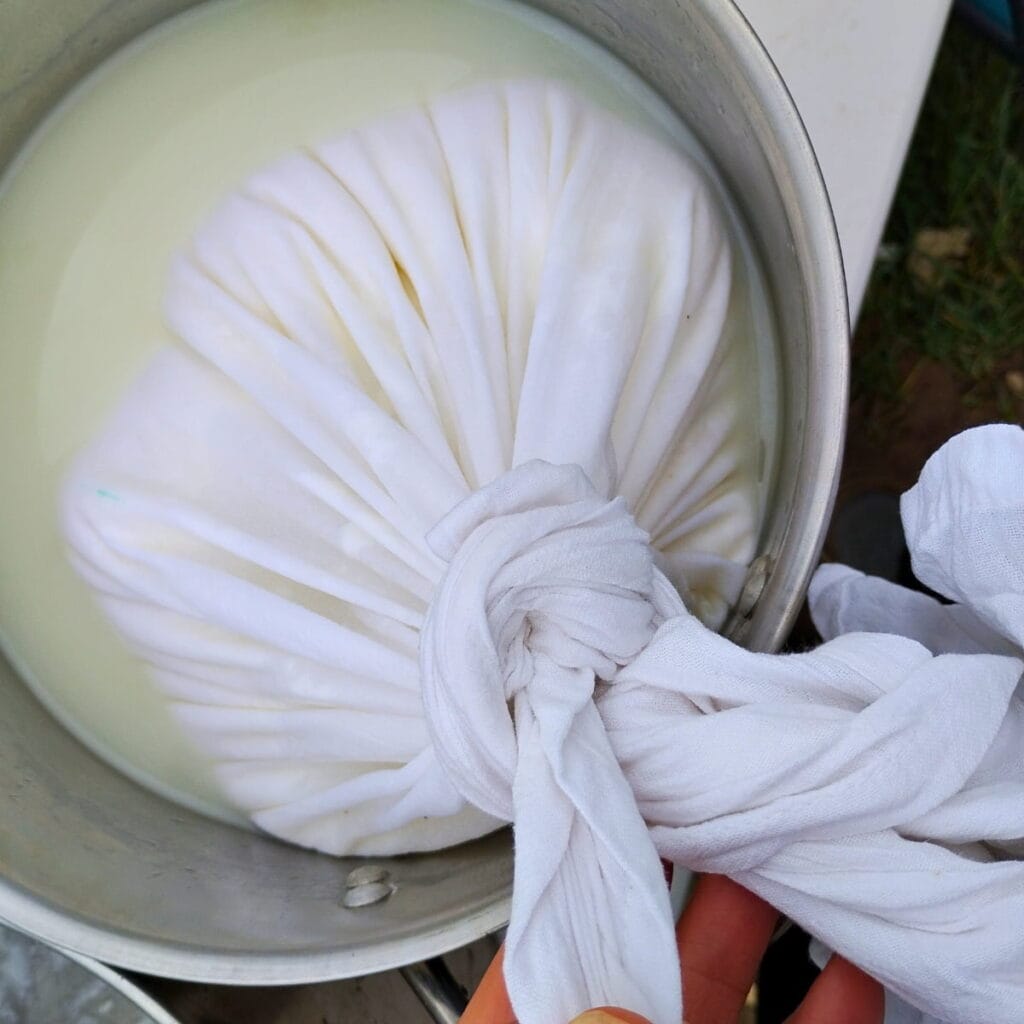
Tie up the corners of the cheese cloth, make a good, secure knot.
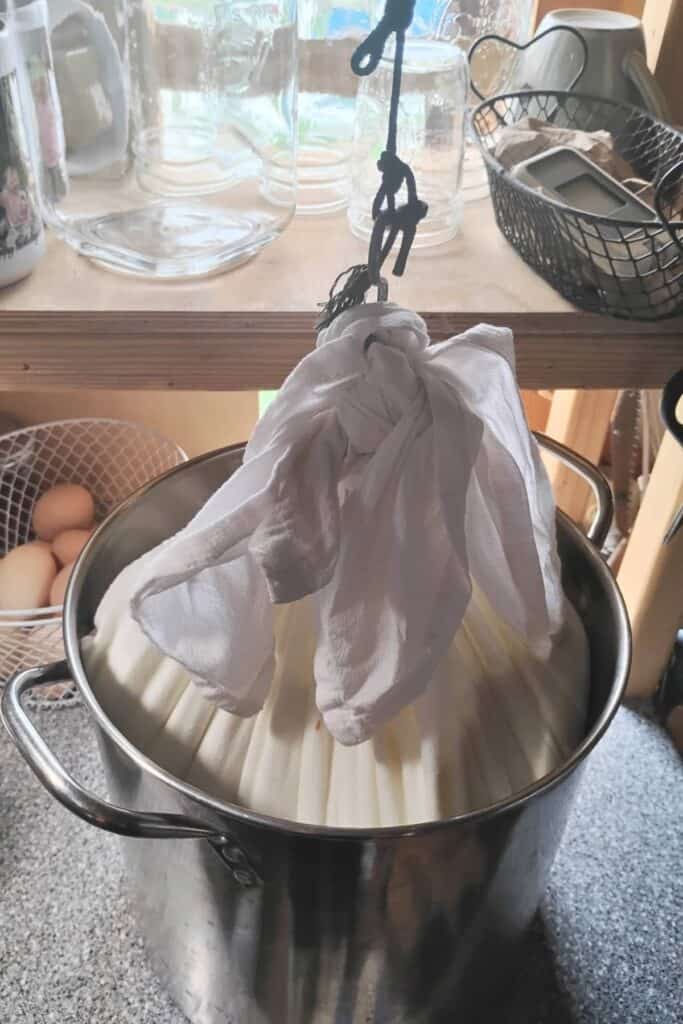
Now hang this over a large wooden spoon that is balanced over the pot or you can hang it from a cabinet knob, or a hook that hangs from the ceiling which is what I do.
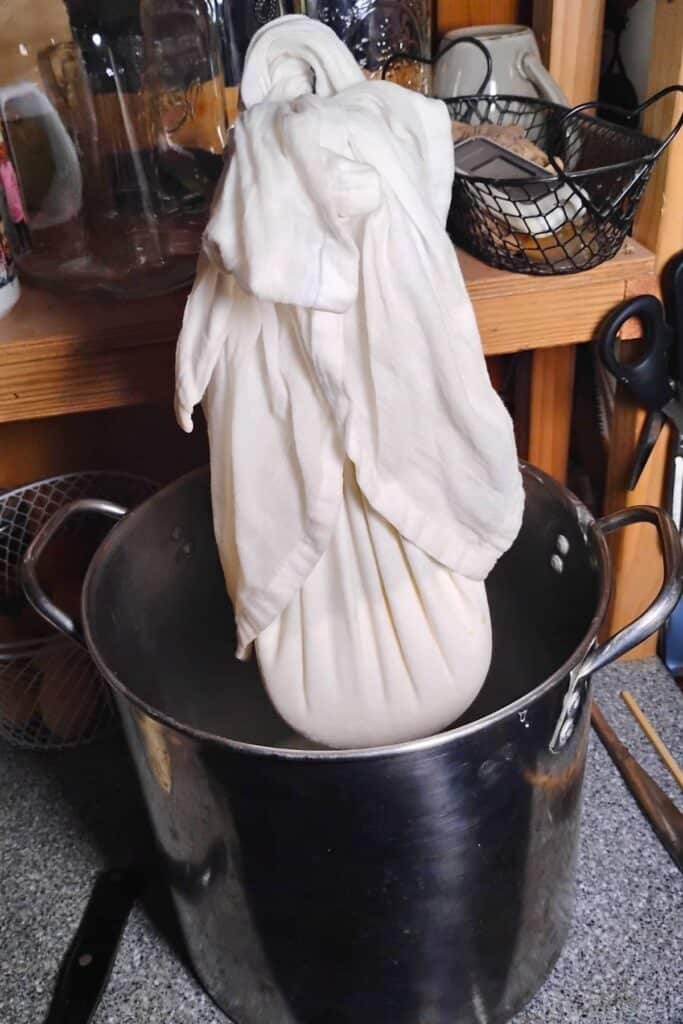
Now let it hang till it drains to the desired consistency. I usually give it 12-24 hours. Much depends on how warm it is and how firm your curd was. The firmer curd drains faster than the softer curd. Check after 12 hours and if there is still a lot of whey in the cheese, take it down and scrape the sides, turn the curds over in the cheese cloth and hang it back up.
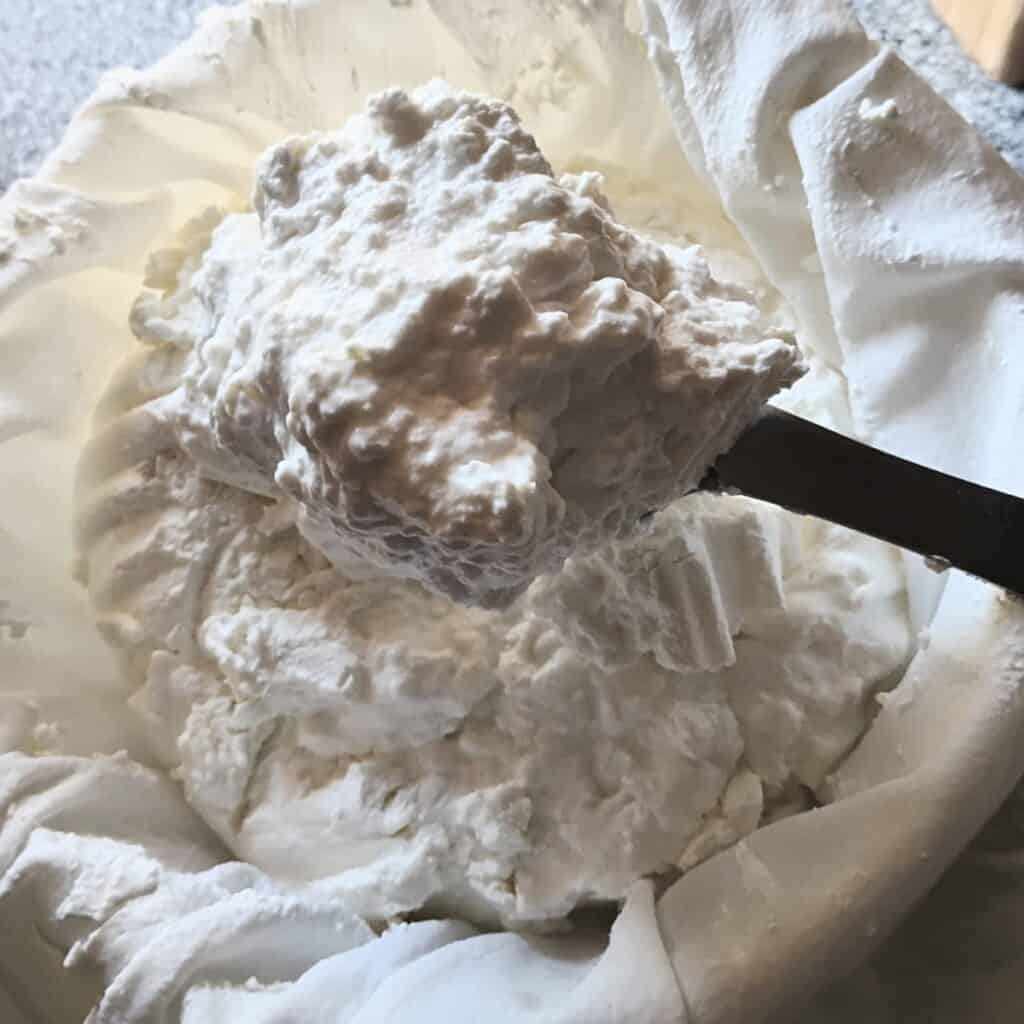
Once it’s fairly firm, you’ve got quark. Yay, that’s all there was to it. How hard was that?!
How to store the cheese
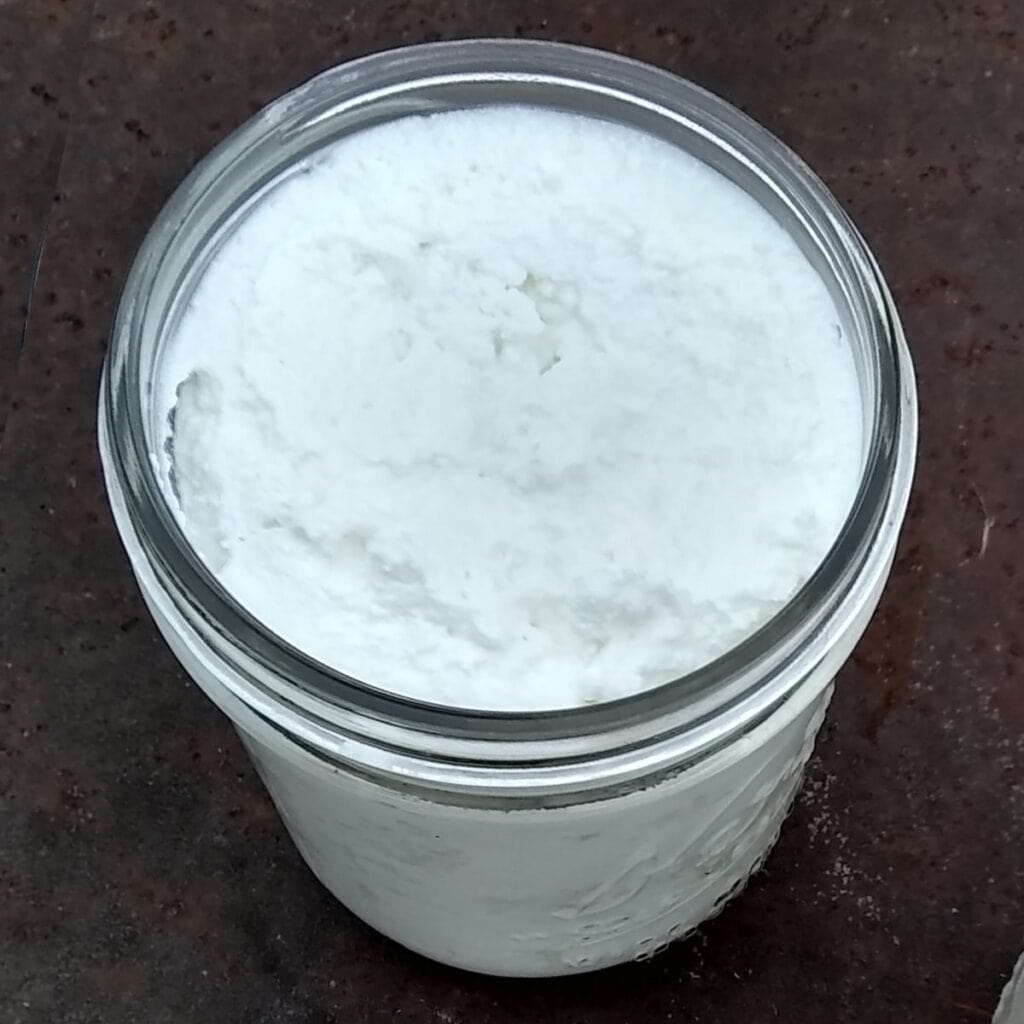
If you don’t use the cheese right away, you can store it in a non-reactive container in your fridge for up to two weeks. You can salt it for longer storage. Use about one tablespoon of salt per gallon batch or one teaspoon per half pound of cheese. Pack the cheese without air pockets and fill all the way to the top. Press down with a spoon and smooth the surface for best results. Seal very tight.
I age my salted soft cheeses for months inside pint canning jars, however they will have a stronger flavor as they get older. But this is how I get stocked up so I have cheese through my goat’s dry-off period before they kid and before I have fresh milk again.
How to use Quark
There are countless recipes available in German cookbooks that use quark. It is so very common, even more so than cream cheese in America. For this reason it surprises me that it is not more common here where there are sizable German populations.
It’s like they came here and forgot about quark. I can’t imagine that. Maybe they all just started making it at home? In any case, there are so many ways to use quark and if you do a search on-line you might find quite a few recipes. I’ll list some here and I’ll be posting some quark recipes in the future too, stay tuned.
Some German recipes list substitutions, but they are not quark and the result is not the same as when using quark. But since quark is so easy to make, it does not need to be substituted.
German Quark Recipes
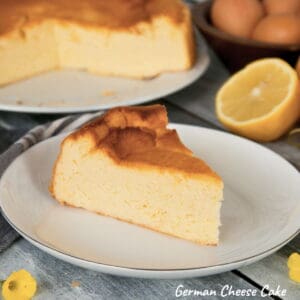
Quark Cheese cake – The famous German cheese cakes are not like those made with dense Philadelphia cheese. German cheese cake is fluffy, less fatty, and has a fresh lemony flavor. Quite different from American cheese cake and quite wonderful.
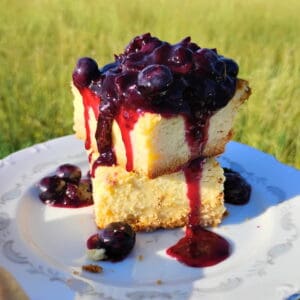
Lemon Blueberry Cheesecake Bars – Creamy, with a buttery crust, this cheesecake dessert is bright, tangy, easy, and perfect for summer gatherings, or any sweet cravings!
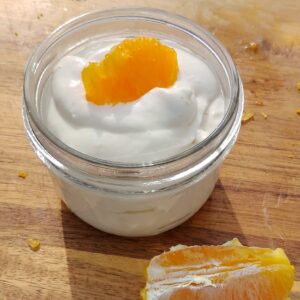
Quark Creme – This is a dessert that uses quark as a main ingredient. It is normally made with low-fat Quark, whipped cream, and flavorings. Quark creme used to be one of my very favorite desserts when I was growing up. It’s delicious!
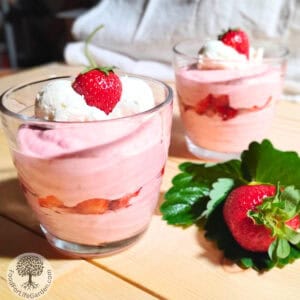
Awesome Strawberry Quark Cheese Mousse – A delicious German quark dessert with pureed strawberries. Healthy, protein-rich and easy to make for every day or special occasions.
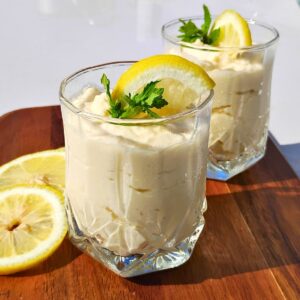
Lemon Cheesecake Mousse – A decadent, outrageously delicious, super healthy lemon dessert made with honey & lemon curd.
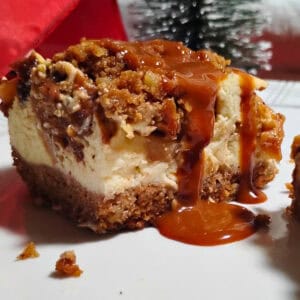
Maple Walnut Cranberry Apple Cheesecake Bars – Awesome for anytime, but spectacular for the holidays!
Quark Taschen – This is like a turn-over, ‘Taschen’ translates to Pockets. They can be sweet or savory. Use a croissant or puff pastry dough and fill it with sweetened quark and fruits or salty quark and herbs. Here is a simple example for a sweet version, written in English. I haven’t tried it.
Using Quark In Everyday Meals
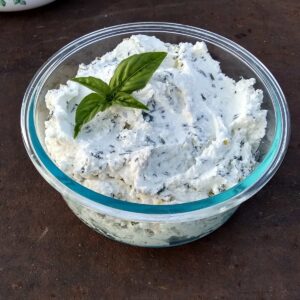
Mix fresh quark with herbs and salt for a dip, or spread on bread or crackers.
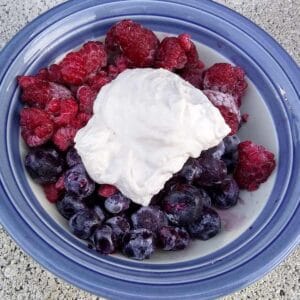
Mix fresh quark with honey and serve over fresh Berries for a delicious and healthy sweet treat.
Make a fruit compote and serve it with plain or honey-sweetened Quark instead of whipping cream or ice cream.
Use it to make salad dressings or smoothies.
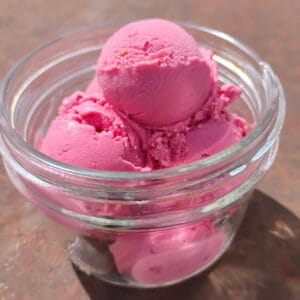
Make quark ice cream, using a frozen yogurt recipe.
Use in place of ricotta cheese in baked dishes.
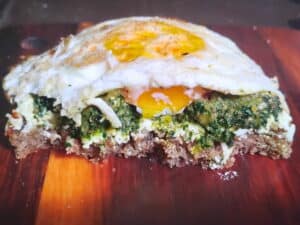
Use as a sandwich spread. Here I used quark as a base, added pesto and topped with fried eggs.
Use in all cream cheese recipes for a lighter and healthier version.
Stir into cream soups for a bit of tang, instead of sour cream.
Use on baked potatoes with some herbs and other dishes in place of sour cream.
Use your imagination. Once you taste it, I assure that you’ll come up with all sorts of ideas to use this versatile cheese.
What To Do With All That Whey?!?
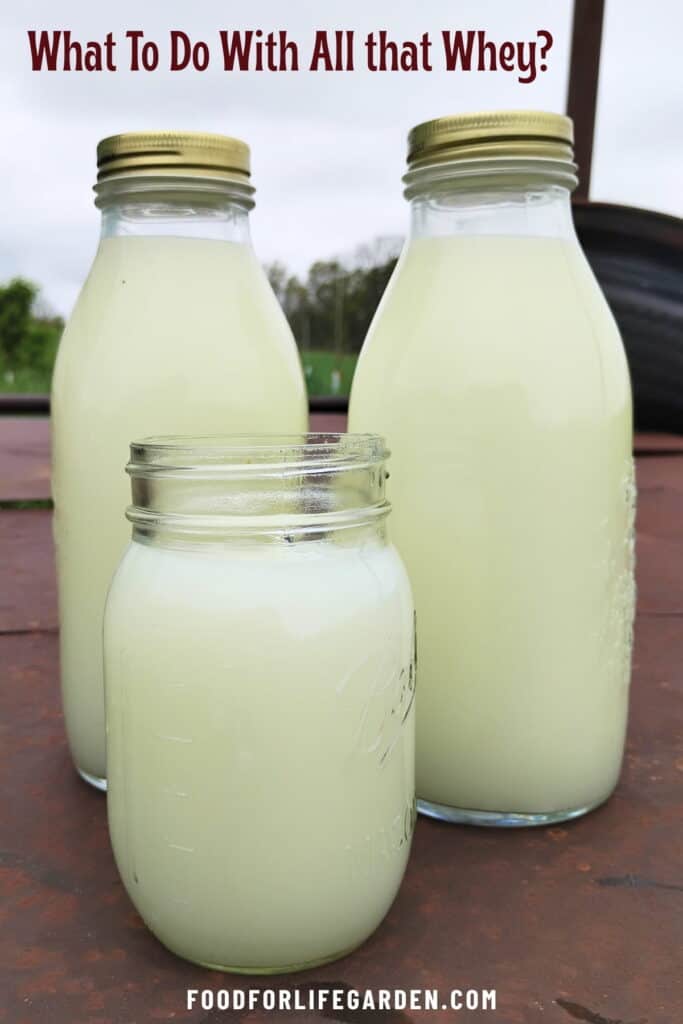
Great question! I’ve had many years to come up with uses for my whey and after all this time, have accumulated quite a sizable list of things to do with whey. When you have a lot of whey, you need to figure out something. Athletes spend a fortune on whey powder for a reason. It would be a huge crying shame to pour that awesome, nutrient rich food down the drain. So I beg that you don’t. Save it and read more in dozens of ways to use whey!
Your Questions Answered
What is Quark called in America?
There is no word for it in America. It is sold as Quark when you can get it in a store. However, you might find fromage blanc or fromage frais, which are similar but creamier and you can use them interchangeably. Fromage frais will have active cultures, fromage blanc will not.
In dictionaries it is called curd cheese. I have not found that anywhere in a store though. Another name for quark might be lactic cheese. It isn’t sold in stores either, but you can find recipes to make it and the process is the same.
It could possibly be compared with Greek yogurt or labneh, which is a middle eastern cheese, but both of those are thermophilic cheeses and they are a bit different in texture, certainly in taste, and the way they react to cooking or baking.
I think the closest we have here in America is Chevre, which is made with goat’s milk, although it usually tastes goaty when you buy it in the store. But if you make it at home, it doesn’t taste at all goaty, unless you let the milk age for a while before using it, or if you keep your billy goat with the does in tight quarters during mating season. If you’ve ever smelled a billy goat during mating season, you know what I’m talking about.
Another cheese that is very similar is clabber cheese, but that one is made without rennet. Clabber cheese was the original quark and so it is completely interchangeable.
Some compare quark with cottage cheese, but it is not like the store bought cottage cheese at all. You could use Quark to replace cottage cheese in many recipes, but cottage cheese would not be the best replacement for Quark in most cases, unless maybe you blend it smooth and omit the salt in recipes.
There is a cool article on wikipedia about Quark, its origins, names, countries where it’s popular and how it’s used around the world.
Can I freeze Quark?
Yes, however, it will change the consistency of the quark. After defrosting it in the refrigerator, some of the water will separate out and there might be some small clumps in the quark. You can use it for cooking and baking no problem, just blend it well. It’s not ideal for fresh use, but if you blend it well, it might work for some dishes.
Does Quark Taste Like Cheese?
While it is a cheese, it doesn’t really taste like cheese. It’s a fresh, mild, slightly tangy, unaged cheese, and it is normally unsalted. It is a bit like cream cheese but is usually made of whole or lower fat milk and so it’s not as heavy, dense and creamy as cream cheese. Some call the taste to be between yogurt and cottage cheese.
What is another name for Quark cheese?
Other European cultures use cheeses that are similar to or exactly like quark. In France it is Fromage Blanc, in Austria, Switzerland and some parts of Germany it is Topfen. They call it Kwark in Holland, Kvarg in Norway, and Tvaroh in Czechoslovakia.
Is Quark Healthy?
Yes! Quark is very healthy. It contains probiotic bacteria that are gut friendly and help with digestion. Especially if it is made with raw milk.Then it contains quite a diverse variety of live bacteria and enzymes. Making quark can turn pasteurized milk into gut-healthy food that even some dairy sensitive people can easily digest. There are no strange ingredients in quark. It’s just milk and sometimes rennet.
So Now That You Have Some Wonderful Quark, Enjoy It!

The best thing about quark is that it’s so versatile. I love it for its health benefits, but aside from that, it’s just plain fun to use in cooking and baking and to make desserts. It’s like a blank canvas, full of possibilities. Create something sweet or savory, hot or cold, plain or fancy.
I’d love to hear how you like quark and what great uses you found for it. Let me know if you’ve had it before and what you think. And do ask me if you have any questions in the comments below.
To get more recipes like this and other information about homesteading and traditional skills, sign up for my Food For Life Garden News, and I’ll let you know when I post new information.
What to read next
How To Make Sirene (Bulgarian Feta) -Try making your own feta-style cheese. Learn all about this wonderful and easy to make cheese and get the recipe!
Make Cheese With Sourdough Starter from scratch. No raw milk required!
Maple Walnut Cranberry Apple Cheesecake Bars – Fantastic flavor, wholesome ingredients, great holiday dessert.
Blackberry Cheesecake Streusel Bars – A must make dessert for blackberry season. Creamy, easy, and berry delicious!
Lemon Cheesecake Mousse – A decadent, delicious, super healthy lemon dessert made with honey & lemon curd.
Creamy Quark Dessert With Oranges – Use quark in a German dessert, a creamy, luxurious mousse, healthy enough for every day desserts, but fancy enough for special occasions.
Awesome Strawberry Quark Cheese Mousse – A delicious German quark dessert with pureed strawberries.
Lemon Blueberry Cheesecake Bars – Creamy, with a buttery crust, this cheesecake dessert is bright, tangy, easy, and perfect for summer gatherings, or any sweet cravings!
Classic German Cheesecake (Käsekuchen) – How to make an incredibly delicious German cheesecake using Quark. Must try this!
Awesome Uses For Whey – Save the whey! And use it in dozens of ways. You’ll find something to do with whey for every single drop. It’s nutritious, versatile, healthy, and makes great fizzy sodas!
Natural cheese making Process – Make your own mesophilic and thermophilic cheese starter and use it to make cheese the natural way. Make yogurt from scratch with your own homemade starter too.
Make your own chevre cheese from scratch – How to make super versatile creamy, spreadable cheese that can be used as a dip, or spread, for baking, for savory or sweet shakes, fresh or aged. Replace store bought cream cheese with this healthy version!
Bonnyclabber – What is clabber milk and its uses Learn to make bonnyclabber, the original cheese. Nature’s way of preserving milk. A tasty, creamy cheese that makes a really good frosting for einkorn zucchini bread.
Queso Fresco cheese recipe – The quickest, easiest cheese you’ll ever make and so versatile!
How to make your own sourdough starter – This forms the basis for any sourdough bread. Once you get a starter going, you can keep it going for a hundred years or more. Just feed it occasionally and use it to bake whenever you like. Transforms a hard to digest bread into bread that your gut will be happy about.
Make an ancient grain sourdough bread – The easiest sourdough sandwich style bread you can imagine. No kneading required and it bakes up nicely airy and chewy and tastes amazing.
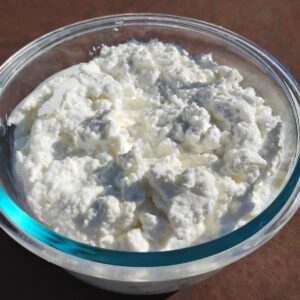
How To Make German Quark Cheese Or Topfen
Equipment
- A 6-8 quart stock pot – It must be non-reactive material such as stainless steel or enamel.
- A skimmer with holes – if you don't have one, you can stir with a slotted turner or even a spoon, but a utensil with holes will mix things better.
- Measuring cups and spoons – ½ cup size
- A cheesecloth – Do not use the kind from the grocery aisle. It won't work. Use a flour sack towel, tea towel, piece of butter muslin, cheesemaker's cheese cloth, or a new cloth diaper,
- A second pot or large bowl – for transferring your curds later.
- Storage container, non-reactive – I recommend glass, or stainless steel. Plastic can leach flavors and chemicals and the acidity of the cheese can leach particles from metal such as aluminum.
Ingredients
- 1 gal Milk – See notes!
- 1/4 cup Starter culture – Whey, kefir, clabber, active buttermilk. If using freeze dried culture, follow package directions for dosage. If using raw milk, cut dosage in half. See notes!
- Rennet – Optional. See notes!
- Calcium Chloride – Only needed for pasteurized milk. See notes!
- 2 tsp Salt per pound of quark – If you plan to store the quark for long-term
Instructions
Warm The Milk
- Slowly warm your milk while stirring occasionally. Heat it to 80 degrees if it's goat's milk. Heat it to 86 degrees if it's cow's milk. If you're taking milk straight from the dairy animal, there is no need to heat it first, just pour it into your cheesemaking pot and proceed.
Add The Starter Culture
- Take the pot off the heat and add the starter culture. If you want use calcium chloride, add it now as well. If you're using a freeze dried culture, sprinkle the correct amount over the top of the milk and let it hydrate for two minutes. Then stir it in.Stir well with an up and down motion, and try to stay below the milk surface.
Add The Rennet
- Prepare your rennet by diluting it in 1/4 cup of water. I fill a half cup measure half way for this, less chance of spillage. It doesn't need to be exact.If you use rennet, add one tablespoon of the the diluted rennet now and stir well with up and down motions without breaking through the milk surface. Only stir for about 20 strokes, then use your skimmer to stop the milk movement. The rennet will start working immediately and the milk should stay very still throughout this incubation period. Cover the pot and don't move the pot till it's done. Jiggling it might break the curd inside which will release whey and disrupt the process. Rennet only works once.
Incubate
- Wrap the pot in a thick towel and let it sit undisturbed for 12-24 hours. In a cool environment it might take longer. If your room is very warm, check after 12 hours to see if your whey is separating. You'll see a curd cake in a bath of whey if it has. Take a knife and make a small cut into the curd to see if it breaks cleanly. If not, give it more time. Otherwise you can proceed.
- Once the curd and whey start to separate and you get a clean break when you cut the surface of the curd, It's time to drain the curds.
Transfer The Curd
- I like to pour off some of the whey first if possible into another container. But you don't need to do that. If your curd is a bit firm, you can cut a criss cross pattern into it to facilitate drainage later.
- Line a second pot or large bowl with a cheesecloth. Take your skimmer and cut into the curd, taking slices and transferring them to the cheesecloth lined pot. Keep moving the whey from the pot to the cheese-lined pot until you have all of it. If you want to pour the rest on the bottom of the pot into the cheesecloth, do so carefully, using your skimmer to keep it from splashing too hard. You don’t want to mash the curds.
Draining The Curd
- Tie up the four corners of the cheese cloth and hang them over a large wooden spoon that is draped over the pot or you can hang it from a cabinet knob, or a hook that hangs from the ceiling which is what I use.
- Now let it hang till it drains to the desired consistency. I usually give it 12-24 hours. Much depends on how warm it is and how firm your curd was. The former curd drains faster than the softer curd. Check after 12 hours and if there is still a lot of whey in the cheese, take it down and scrape the sides, turn the curds in the cheese cloth and hang it back up.
- Once it's firm, you've got quark! Yay, that's all there was to it. How hard was that?!
Notes
Milk
Raw milk is going to yield the best results in every way and for its health benefits, it is not replaceable. I use only raw goats milk currently, but I had cows before and used raw cow’s milk in the past and that works just as well. But I realize that raw milk is not available to everyone, and so I’ll include instructions for pasteurized cow’s milk. The good thing when making cheese with your pasteurized milk is that some of the good bacteria gets added back in, which makes pasteurized milk a little healthier again. Do avoid Ultra-pasteurized milk. This won’t work for most cheese recipes because it has been over processed and denatured. It is structurally very different from raw milk and even from pasteurized milk. I use full fat goat’s milk for my quark and it yields a very rich quark. But most quark you buy in Germany is actually low fat. You can use 2% milk to get a less fatty quark, which will most resemble what you can get in German markets. If you use raw, or un-homogenized cow’s milk, just skim off some cream to use elsewhere and use the skimmed milk for quark.Natural Starter culture
Here you have several options. Make your own starter culture if you have raw milk available. See how in the natural cheese making process and follow the instructions to make mesophilic culture. Or just follow the instructions on making bonny clabber, which will be your starter culture. This is the ideal and preferred way to make a natural, traditional quark. You can also use mesophilic whey from previous cheese making. Use the whey from any cheeses that had been cultured at medium temperatures. Another culture you can use is buttermilk from the store. However, you’ll need to make sure that it contains live bacteria. This won’t work with pasteurized buttermilk. The health food store might be your best place to get a live culture buttermilk. If you have access to milk kefir, it will make a superb starter culture for your Quark. I recommend live grains if you want to start your own. Kefir has a huge diversity of living organisms, greater even than yogurt and you’ll get lots of good bacteria to feed your gut microbiome when using it. It isn’t the best for all cheeses, but it is awesome for most. I’ve made all sorts of cheeses using kefir with great results. In fact if you can’t find buttermilk with live bacteria in the store you might be able to find an unflavored milk kefir, which normally includes live bacteria. Check the label though.Purchased Freeze Dried cultures
Your final option is a purchased mesophilic culture such as flora danica, which has a more diverse selection of bacteria than your standard freeze-dried mesophilic cultures, which are ideal for a soft cheese. You’ll use 1/8 teaspoon and sprinkle it over the top of the warmed milk and let it rehydrate for a few minutes before stirring it in. Flora danica would be my first choice from all the freeze dried options. Alternatively you can purchase buttermilk culture. And you can also use freeze dried mesophilic culture, but it will not yield as good of a result due to the type of bacteria it is based on. In a pinch, purchased chevre culture or fromage blanc culture will also work. However, do not use rennet with these. It is already included.Calcium Chloride
You don’ t need this when you use raw milk. But since calcium becomes denatured by pasteurization, you might need it for pasteurized cow’s milk. You can certainly try to make this without the calcium chloride though. It is possible that it will work. But if you have trouble getting your cheese to coagulate, I’d add some calcium chloride next time to see if this solves the issue.Rennet
Rennet is optional for this cheese. Using rennet yields a firmer, quicker cheese, while omitting it yields a softer, creamier and tangier cheese that takes a little longer to make. I prefer it without rennet, but I often use rennet if I want it to go faster. It will set and drain quicker. I use kid rennet for my cheeses for two reasons. One, Walcoren uses all natural organic, non-gmo ingredients, and second, because I use goat’s milk and I feel that it is a good match. I prefer the liquid kid rennet. This needs to be kept refrigerated. I’ve had my bottle for 6 years and it still works. You need very little for each batch of cheese. You can also get Walcoren Kid Rennet Tablets, I like them, they have a long shelf-life, but I find them harder to dose and they take a few minutes to dissolve. If you like, you can use kid rennet for cow’s milk as well, it contains enzymes that can actually enhance the rather bland flavor of cow’s milk in cheeses. Many cheesemakers add lipase to their cow’s milk cheeses for this reason, but you can skip that if you use kid rennet in your cheese making. It already contains such enzymes. However, the most common rennet used is calf or animal rennet. Look for a non-GMO version. And some people use vegetable rennet. I heard that it makes aged cheeses bitter and that it is better used only on fresh cheeses. I have never used it and don’t intend to. But it is an option if you prefer using vegetable rennet. We’ll be using very little rennet to arrive at the soft, creamy nature of the cheese. It needs to be dissolved in water before getting added to the milk. Take a third cup of water and place three drops of rennet into it. Stir and use only a tablespoon of this mix per gallon of milk.How to store the cheese
If you don’t use the cheese right away, you can store it in a non-reactive container in your fridge for up to two weeks. You can salt it for longer storage. Use about one tablespoon of salt per gallon batch or one teaspoon per half pound of cheese. I age my salted soft cheeses for months, however they will have a stronger flavor as they get older. But this is how I get through my goat’s dry-off period before they kid and before I have fresh milk again.How to use Quark
There are countless recipes available in German cookbooks that use quark. It is so very common, even more so than cream cheese in America. For this reason it surprises me that it is not more common here where there are sizable German populations. It’s like they came here and forgot about quark. I can’t imagine that. Maybe they all just started making it at home? In any case, there are so many ways to use quark and if you do a search on-line you might find quite a few recipes. I’ll list some here and I’ll be posting some quark recipes in the future too, stay tuned. Quark Cheese cake – The famous German cheese cake is very different from the American dense versions. German cheese cake is fluffy and less fatty and has a fresh lemony flavor. Quite different from American cheese cake and quite wonderful. Quark Creme – This is a dessert that uses quark as a main ingredient. It is normally made with low fat Quark, whipped cream, and flavorings. I’ll be posting an example soon for you. Quark Taschen – This is like a turn-over, “Taschen” translates to Pockets. It can be sweet or savory. Use a croissant or puff pastry dough and fill it with sweetened quark and fruits or salty quark and herbs. Here is a simple example for a sweet version in English. Mix fresh Quark with Herbs and Salt for a dip, or spread on bread or crackers. Mix fresh Quark with Honey and berries for a delicious and healthy sweet treat. Use it to make salad dressings or smoothies. Make Quark Ice Cream (similar to frozen yogurt). Use in place of ricotta cheese in baked dishes. Use in all cream cheese recipes for a lighter and healthier version! Stir into cream soups for a bit of tang, instead of sour cream. Use on baked potatoes and other dishes in place of sour cream. Use your imagination. Once you taste it I assure you that you’ll come up with all sorts of ideas to use this versatile cheese.So Now That You Have Some Wonderful Quark, Enjoy It!
The best thing about quark is that it’s so versatile. I love it for its health benefits, but aside from that, it’s just plain fun to use in cooking and baking and to make desserts. It’s like a blank canvas, full of possibilities. Create something sweet or savory, hot or cold, plain or fancy.Pin This Post
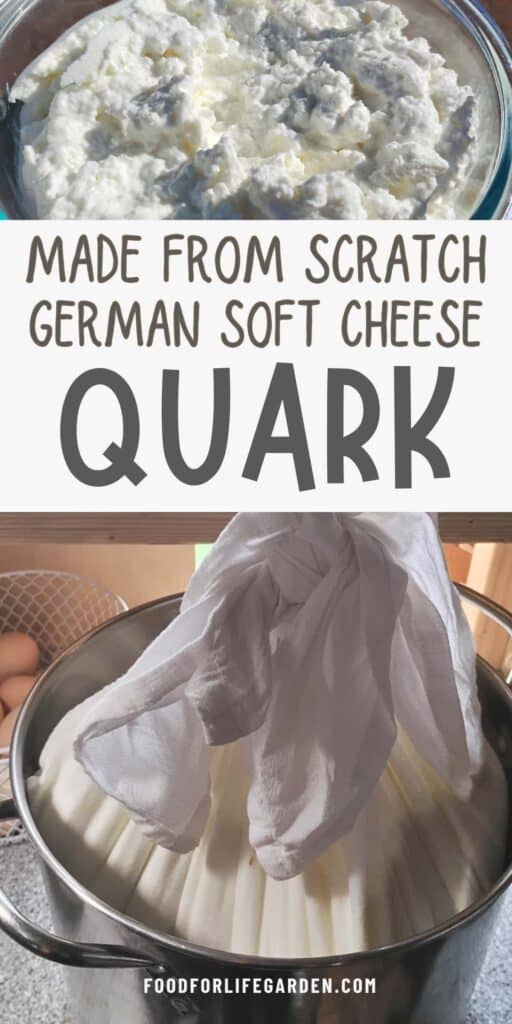
Shop This Post
Royal Berkey water filter unit
A large 6 qt pot
12 quart stock pot
Flour sack towels
Organic flour sack towels
Butter muslin, hemmed on 2 sides
Unbleached Cheese cloth
Organic cheesemaker’s cheese cloth
Cloth diapers
Redmond’s Real Salt
Himalayan Pink Salt
Celtic Sea Salt
Skimmer
Thermometer
Walcoren Organic Kid Rennet
Walcoren Kid Rennet Tablets
Animal Rennet
Vegetable Rennet
Live kefir grains
Mesophilic Culture
Micro measuring spoons
Recommended literature for Cheese making
The Art Of Natural Cheese Making, David Asher
Sourcing Quark
Here is a source for Quark in the US. I found this on-line, but have not tried it.

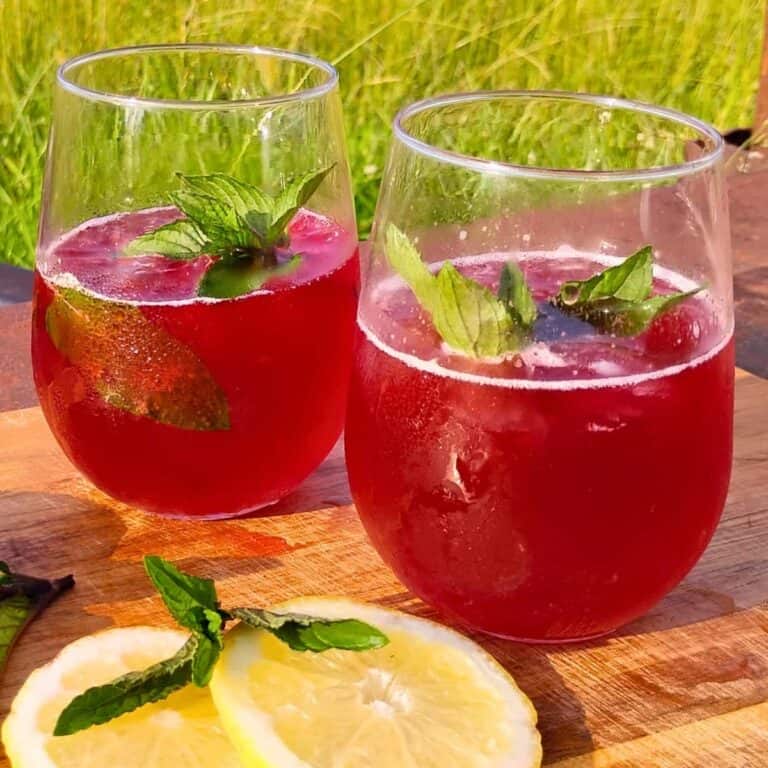
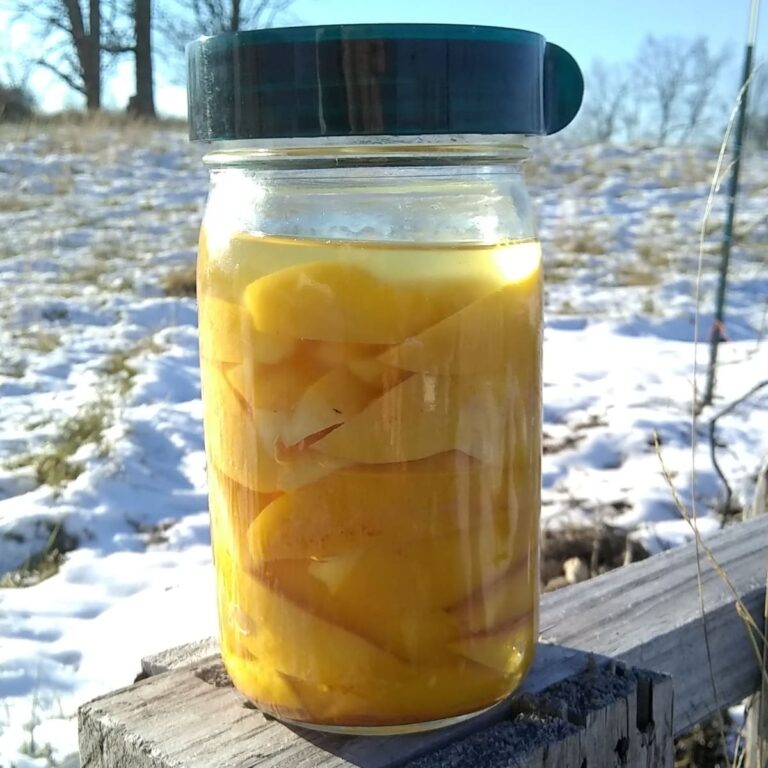
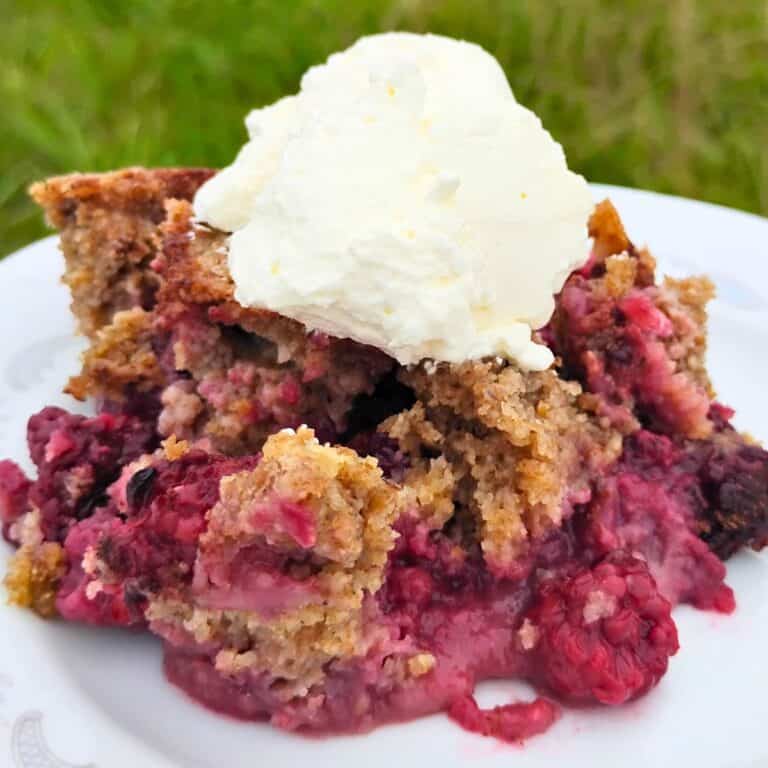
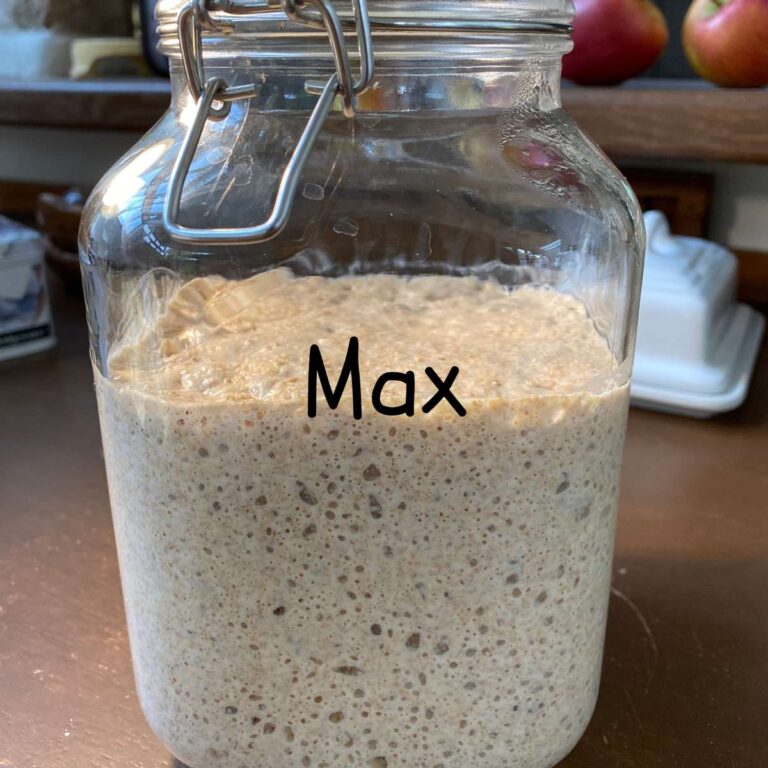
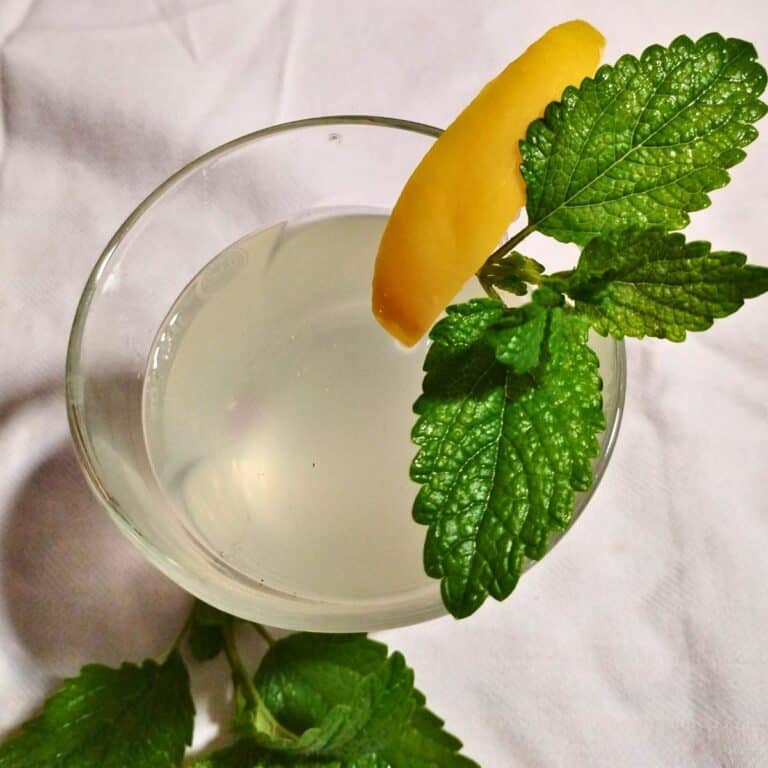
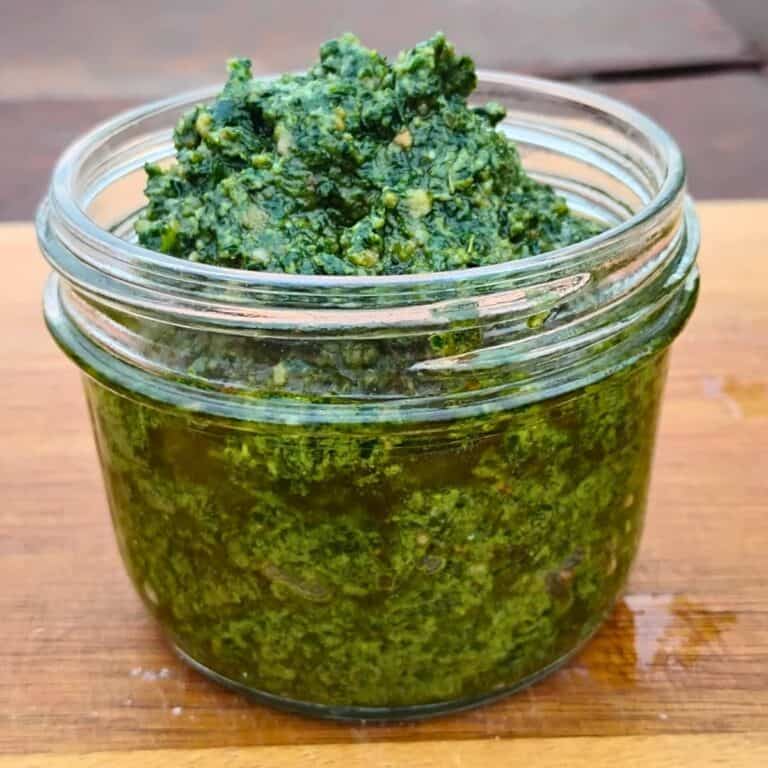
If you miss Quark or if you want a new, easy, awesome cheese to make, try this recipe! Quark is versatile and delicious and German cooking and baking is unthinkable without it. Give it a try and see if you don’t fall in love with this cheese. Ask me here if you have a question!
This is so interesting! I have German roots, but have never tried this. Very informative!
Hey Emily! Thank you so much for commenting and I’m glad if you found this interesting!
Heidi, I ALWAYS learn something new here! I have never heard of Quark but now I am totally in! Looks fantastic!
Haha, it’s really great stuff that deserves more attention here in America in my humble opinion. Glad if you liked this!
Very cool! Would love to try this someday 😊
Hey Ashleigh, I’d love to hear about it if you do!
How interesting! I love cheese and I haven’t ever heard of this. I wonder if it isn’t as common in the Unites States. You always have so much detail in your recipes, they are written so well. Thanks for sharing! 🙂
Thank you so much for your kind comment. I am kind of surprised that Quark is not more common here. Having grown up in Germany, it was everywhere and it would have never occurred to me to come here to the States and not find it anywhere. But hey we can change that!
What a wealth of information! I’m starting to actually understand cheese making better. Quark looks pretty easy to make!
I also find it odd that quark is not available in stores much at all. Same with fromage blanc. Both are so delicious and useful! I loved having quark with fruit when I was in Germany, though I don’t suppose it occurred to me that it was full of probiotics. Nothing against cream cheese, but quark is better. And no gums or anything like that. Need to make this to serve with all the berries that are getting ripe!
Yes, Rachel, berries and quark are a match made in heaven! Thank you so much for sharing this. I find quark very much more healthy than cream cheese. It’s a great health food much like homemade yogurt, only it uses lower temperatures for culturing. Thanks so much for commenting!
This is such a fantastic guide—thank you for explaining it so clearly! I’ve always been curious about making quark at home, especially since we try to include hands-on food projects in our home education. Your step-by-step photos make it feel really approachable. I’m looking forward to trying this with the kids during one of our slower afternoons!
That is so awesome, I think it would make a great lesson for kids and I hope you all love it as much as I do!
I haven’t ventured into too much cheese making, but would love to learn. This seems like a great one for beginners. My children are learning German, and would love this recipe!
How awesome that your kids are learning German. And yes, this is an easy cheese for beginners. I hope you get to try it.
Homemade German Quark sounds delicious! I’m always interested in trying something with a German origin story.
Hey Jenni, that’s great, and it is very delicious!
Wow, what a very interesting process and very well explained as always 🙂 Thank you so much for sharing, I’m saving this for when I can get my hands on some raw milk (I live in Canada and that’s a challenge unfortunately!). Can’t wait to learn to make some cheese!
That’s too bad you can’t get raw milk easily, but you could try making it with pasteurized milk and just adding a culture. Thanks so much for commenting 😊
I’m SO glad you wrote this post! I also grew up in Germany and have been living in Ireland for 16 years now. I really missed eating Quark and using it in recipes that I knew from my childhood. Thank you for sharing!
You’re so welcome! I’m surprised that quark is not sold in Ireland. But it’s not hard to make some. You might give it a try!
I’ll be honest, I had no idea what Quark was until I found this recipe! I’ll be making a lot more of your recipes now that I know how to make Quark. Thank you teaching me something new!
You’re welcome and thank you for commenting. Quark is really awesome stuff, I’m sure you’ll love it!
I look forward to trying this recipe with kefir. I’ve wondered if cheese could be made out of this!
Thank you for sharing!
Hi Kayla, thank you for your comment. Yes, after making the recipe and draining the whey, you’ll be left with a spreadable soft cheese. However you can also salt it and pack it into jars very tightly and up to the rim, seal and it will keep a long time. You could also make feta cheese with it, I’ll post a recipe soon for that. So to answer your question, Quark is considered a cheese, but it will not make a hard cheese. For this you’ll need more rennet and likely a cheese press.
This makes me want to buy a milk cow again! I love dairy! Giving this a try asap!!
Hey Jennifer! That’s awesome, I am confident that you will love quark. And yes, having dairy animals is awesome!